Hanwha Techwin DIGIMAXV6 Digital Camera User Manual
Samsung Techwin Co Ltd Digital Camera Users Manual
Contents
- 1. User Manual 1
- 2. User Manual 2
User Manual 1
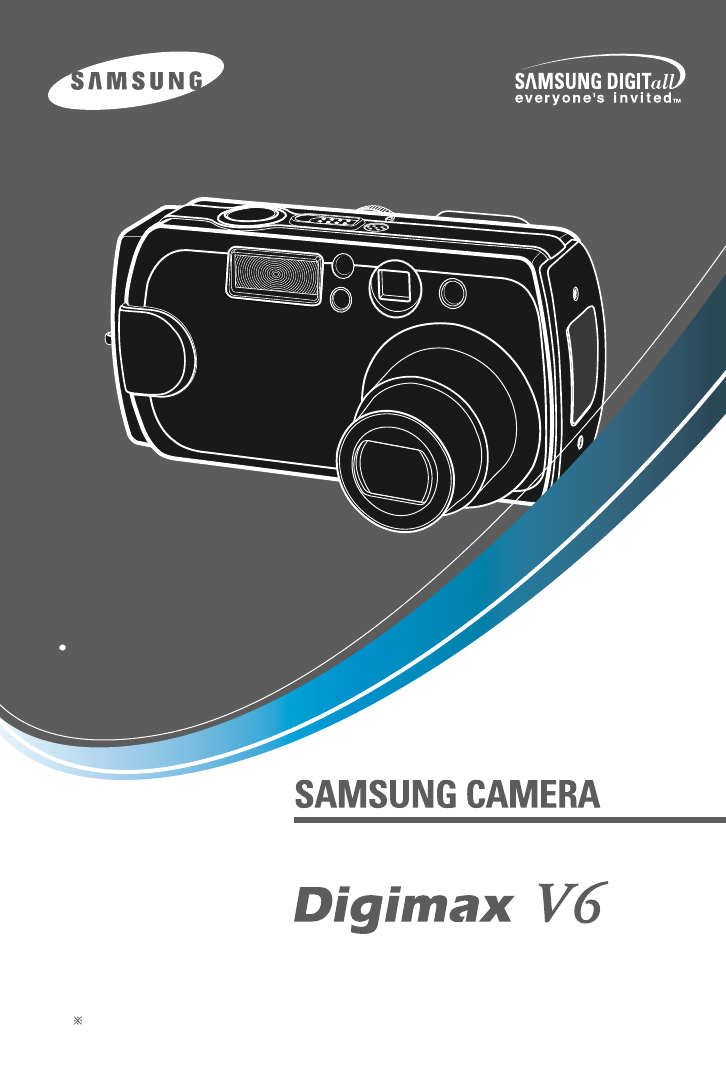
Thank you for buying a Samsung Camera.
This manual will guide you through using the camera, including capturing images, downloading images and
using the application software. Please read this manual carefully before using your new camera.
Figures (Images) used for the manual are based on model Digimax V6.
ENGLISH
Digimax V6000
User's Manual
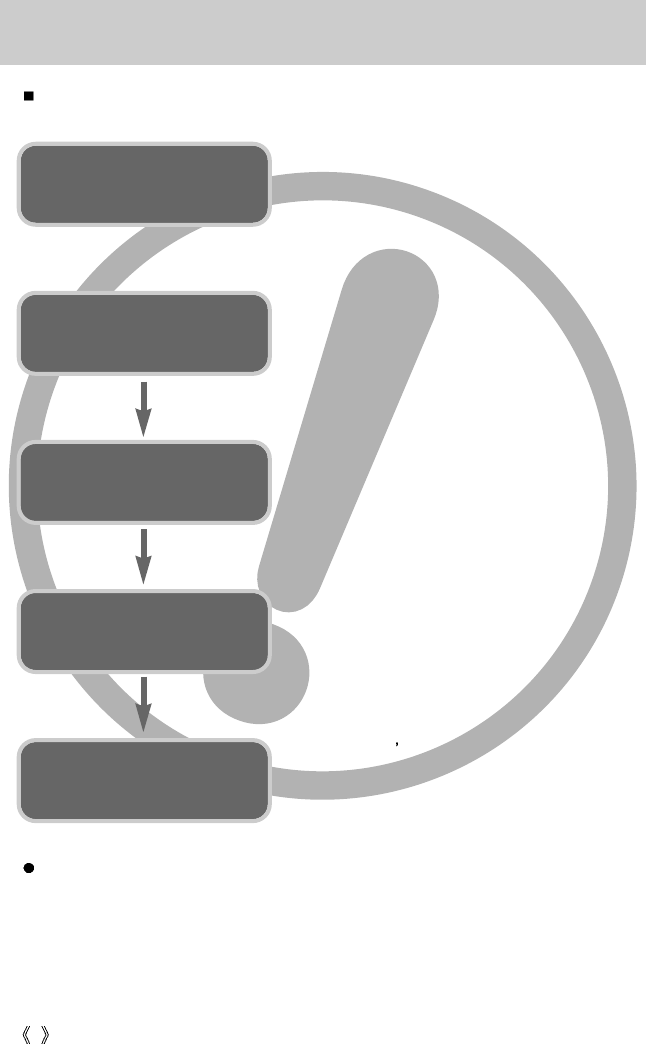
2
Instructions
Use this camera in the following order
Insert the
USB cable
Set up the
camera driver
Before connecting the camera to a PC, via the
USB cable, you will need to set up the camera
driver. Install the camera driver that is contained in
the Application S/W CD-ROM.(p.99)
Take a picture (p.21)
Insert the supplied USB cable into the PC’s USB
port and the camera’s USB connection
terminal.(p.105)
Check the camera’s power
If the power is turned off, slide the camera switch to
power it on.
Take a picture
Check the
camera’s power
Check
[Removable Disk]
Open Window s EXPLORER and search for
[Removable Disk].(p.106)
If you use a card reader to copy the images on the memory card to your PC, the images
could be damaged. When transferring the images taken with the camera to your PC, be sure
to use the supplied USB cable to connect the camera to your PC. Please note that the
manufacturer holds no responsibility for loss or damage of images on the memory card due
to the use of a card reader.
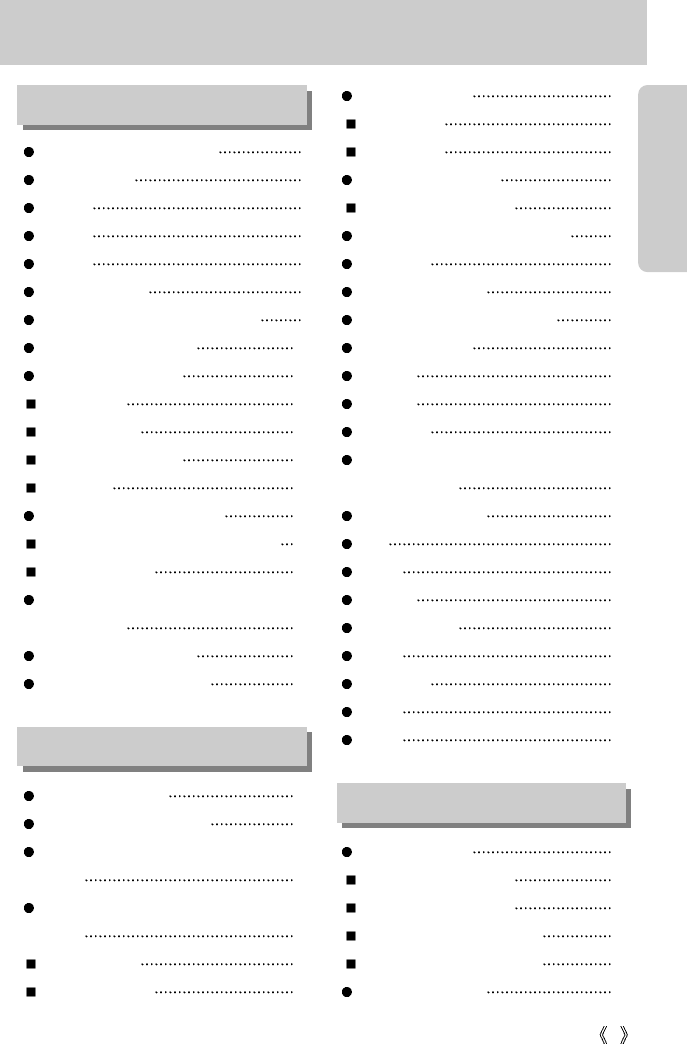
3
Contents
Getting to know your camera 5
About the icons 5
Danger 6
Warning 6
Caution 7
An FCC warning 7
This digital camera can be used for 8
Manufacturer's contents 10
Identification of features 11
Front & Top 11
Back & Bottom 11
Side/ 5-function button 12
Mode dial 12
Connecting to a Power Source 15
Using the AC power adapter (5V 2.0A) 15
Using the batteries 16
Instructions on how to use the
memory card 17
Inserting the memory card 19
Removing the memory card 19
LCD monitor indicator 20
Starting the recording mode 21
Things to Watch Out for When Taking
Pictures 26
Using the camera buttons to adjust the
camera 27
POWER switch 27
SHUTTER button 27
ZOOM W/T button 27
TELE Zoom 28
WIDE Zoom 28
Voice memo/ UP button 29
Recording a voice memo 29
MACRO / SUPER MACRO button 30
Focus lock 32
FLASH/ LEFT button 33
SELF-TIMER / REMOTE button 35
MENU/ OK button 37
MF button 38
+/- button 41
LCD button 45
Using the LCD monitor to adjust the
camera settings 46
How to use the menu 48
Size 48
Quality 49
Metering 50
Continuous shot 50
Effect 51
Sharpness 52
A/S/M 52
Scene 53
Starting play mode 54
Playing back a still image 54
Playing back a movie clip 55
How to capture the movie clip 55
Playing back a recorded voice 56
LCD monitor indicator 57
READY
RECORDING
PLAY
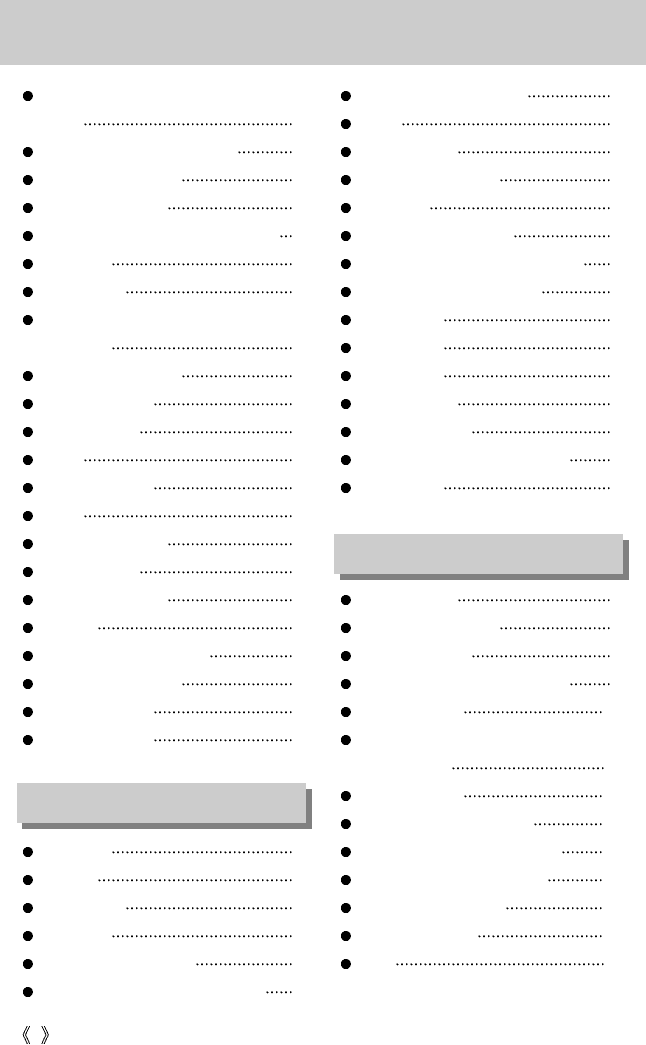
4
Contents
Using the camera buttons to adjust the
camera 58
Thumbnail/ Enlargement button 58
Voice memo / Up button 59
Play & Pause button 60
DOWN/ LEFT/ RIGHT/ MENU/ OK button
61
LCD button 61
Delete button 62
Setting up the play back function using the
LCD monitor 63
Starting the slide show 66
Protecting images 67
Deleting images 68
Resize 69
Rotating an image 70
DPOF 70
DPOF : STANDARD 71
DPOF : INDEX 71
DPOF : PRINT SIZE 72
PictBridge 73
PictBridge: Picture Selection 74
PictBridge: Print Setting 75
PictBridge: Printing 76
PictBridge : RESET 77
Setup menu 78
File name 79
Auto power off 80
Language 81
Formatting a memory card 81
Setting up the Date/ Time/ Date type 82
Imprinting the recording date 82
Sound 83
LCD brightness 83
Selecting Video out type 84
Quick view 85
Initialization(RESET ALL) 85
Connecting an External Device (USB) 86
Setting up the MYCAM menu 87
Start up image 87
Start up sound 88
Shutter sound 88
Important notes 89
Warning indicator 91
Before contacting a service center 92
Specifications 95
Software Notes 97
System Requirements 97
About the software 98
Setting up the application software 99
Starting PC Mode 105
Removing the USB Driver for
Windows 98SE 108
Removable Disk 109
Removing the removable disk 110
Setting up the USB Driver for MAC 111
Using the USB Driver for MAC 111
Using PhotoImpression 112
Digimax Viewer 2.1 113
FAQ 114
SOFTWARE
SETUP
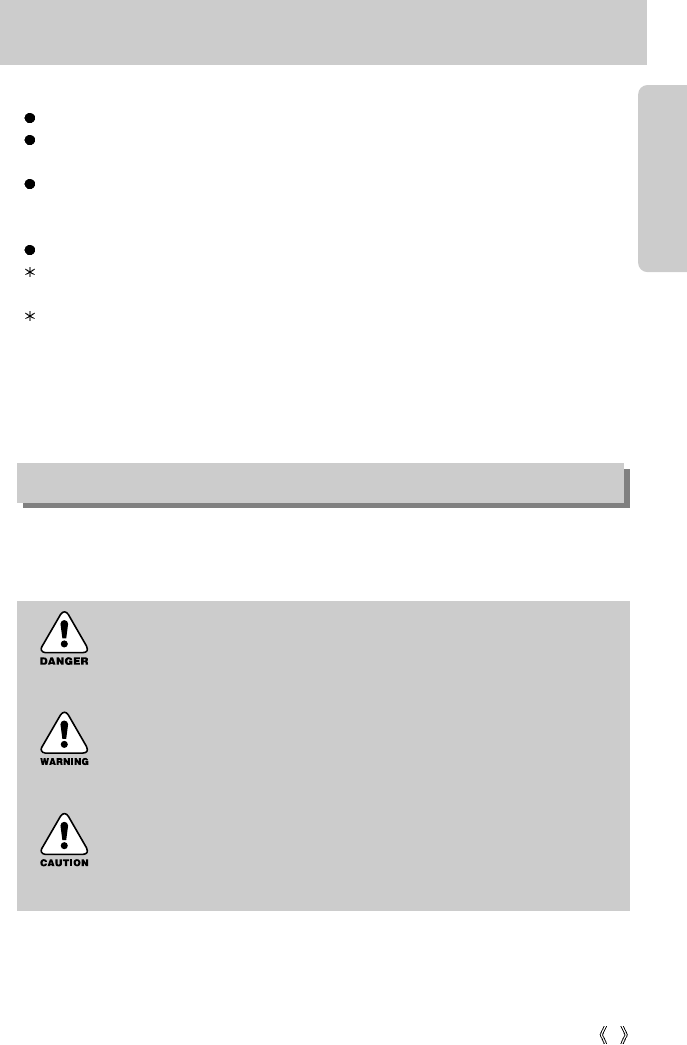
5
Getting to know your camera
Thank you for buying a Samsung Digital Camera.
Prior to using this camera, please read the user manual thoroughly.
When you require After Sales service, please bring the camera and the cause of the camera
malfunction (such as Batteries, Memory card etc.) to the A/S center.
Please check that the camera is operating properly prior to when you intend to use it
(e.g. for a trip or an important event) to avoid disappointment. Samsung camera takes no
responsibility for any loss or damages that may result from camera malfunction.
Keep the manual in a safe place.
Microsoft, Windows and Windows logo are registered trademarks of Microsoft Corporation
incorporated in the United States and/or other countries.
All brand and product names appearing in this manual are registered trademarks of their
respective companies.
This manual contains instructions on using this camera that will help you to use this camera
safely and correctly. This will help prevent danger and injury to others.
About the icons
DANGER
DANGER indicates an imminently hazardous situation which, if not avoided,
will result in death or serious injury.
WARNING
WARNING indicates a potentially hazardous situation, which, if not avoided,
could result in death or serious injury.
CAUTION
CAUTION indicates a potentially hazardous situation, which, if not avoided,
may result in a minor or moderate injury.
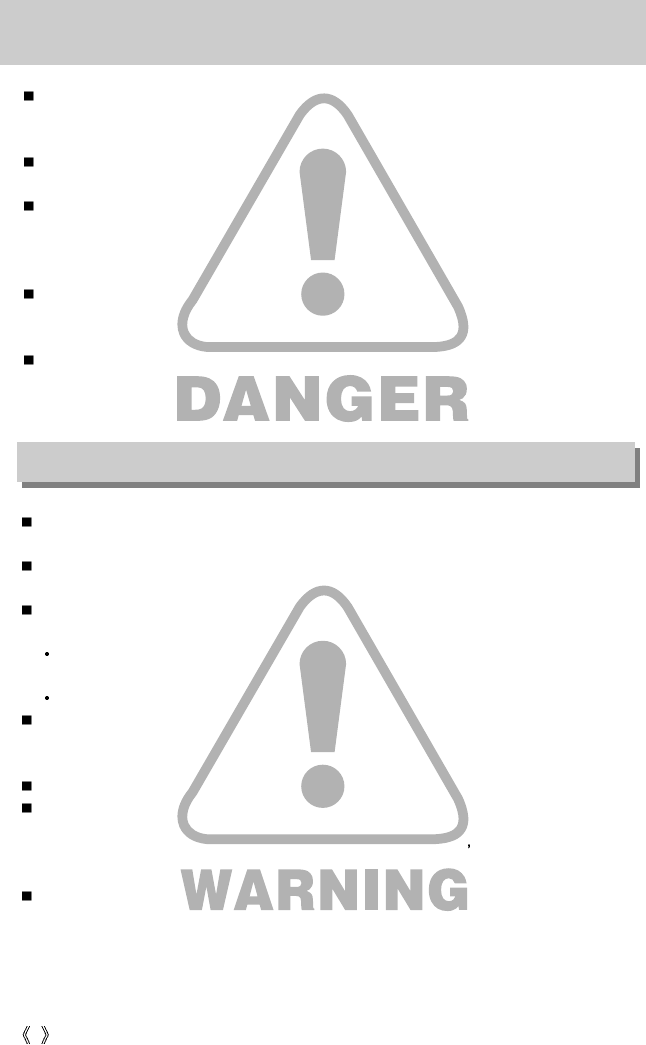
6
Danger
Do not attempt to modify this camera in any way. This may result in fire, injury, electric shock
or severe damage to you or your camera. Internal inspection, maintenance and repairs
should be carried out by your dealer or Samsung Camera Service Center.
Please do not use this product in close proximity to flammable or explosive gases, as this
could increase the risk of explosion.
Should any form of liquid or a foreign object enter the camera, do not use it. Switch off the
camera, and then disconnect the power source (batteries or AC Power Adapter).
You must contact your dealer or Samsung Camera Service Center.
Do not continue to use the camera as this may cause a fire or electric shock.
Do not insert or drop metallic or inflammable foreign objects into the camera through access
points e.g. the memory card slot and battery chamber.
This may cause a fire or electric shock.
Do not operate this camera with wet hands. This could pose a risk of electric shock.
Do not use the flash in close proximity to people or animals.
Positioning the flash too close to your subject’s eyes, may cause eyesight damage.
When taking photographs, never point the lens of the camera directly into very strong light.
This may result in permanent damage to your eyesight.
For safety reasons keep this product and accessories out of reach of children or animals to
prevent accidents e.g.:
Swallowing batteries or small camera accessories. If an accident should occur, please
consult a doctor immediately.
There is the possibility of injury from the camera’s moving parts.
Batteries and camera may become hot during prolonged use and it may result in camera
malfunction. Should this be the case, allow the camera to sit idle for a few minutes to allow it
time to cool.
Do not recharge non rechargeable batteries. This may cause an explosion.
Do not leave this camera in places subject to extremely high temperatures, such as a sealed
vehicle, direct sunlight or other places of extreme variances in temperature.
Exposure to extreme temperatures may adversely affect the camera s internal components
and could cause a fire.
When in use, do not cover the camera or AC Power Adapter.
This may cause heat to build up and distort the camera body or cause a fire.
Always use the camera and its accessories in a well-ventilated area.
Warning

7
Caution
Leaking, overheating, or burst batteries could result in fire or injury.
Use batteries with the correct specification for the camera.
Do not short circuit, heat or dispose of batteries in fire.
Do not insert the batteries with the reverse polarities.
Remove the batteries when not planning to use the camera for a long period of time.
Batteries may leak corrosive electrolyte and irreparably damage the camera's components.
Do not fire the flash while it is in contact with hands or objects.
Do not touch the flash after using it continuously. It may cause burns.
Do not move the camera while it is switched on, if you are using the AC Power Adapter.
After use, always switch off the camera before unplugging the adapter from the wall socket.
Then make sure that any connector cords or cables to other devices are disconnected before
moving the camera. Failure to do so may damage the cords or cables and cause a fire or
electric shock.
An FCC warning
This device has been tested in accordance with the limits of a class B digital device
under item 15 of the FCC rules. These limits are designed to provide protection
against harmful interference in commercial installation. This equipment generates,
absorbs and can emit radio frequency energy. If it is not installed and used in
accordance with the instructions, it may cause harmful interference to radio
communication.
There is however, no guarantee that interference will not occur in some situations.
Should any interference occur when this device is in operation, please try one or
more of the following measures.
Change the location and direction of any aerial.
Increase distance between the camera and the affected device.
Use a different socket away from the affected device.
Please contact a Samsung agent or a radio/TV engineer.
This device complies with part 15 of the FCC Rules.
Changes or modifications not expressly approved by the party responsible for
compliance could void user's authority to operate the equipment.
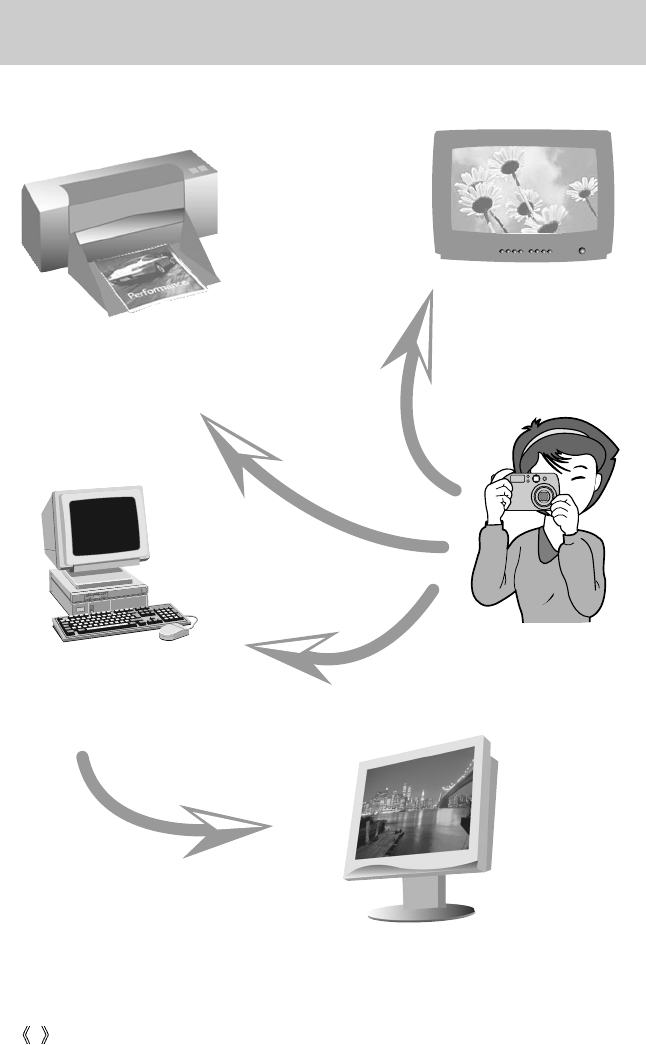
8
This digital camera can be used for
Printing images using a dedicated printer,
DPOF and PictBridge compatible printer or a
DPOF-equipped photo lab.
(refer to page 70~77)
Down loading image files
from camera to computer.
(refer to page 106)
Editing images on a PC.
(refer to page 113)
Viewing images on a TV.
(refer to page 84)
Taking a picture.
(refer to page 21)
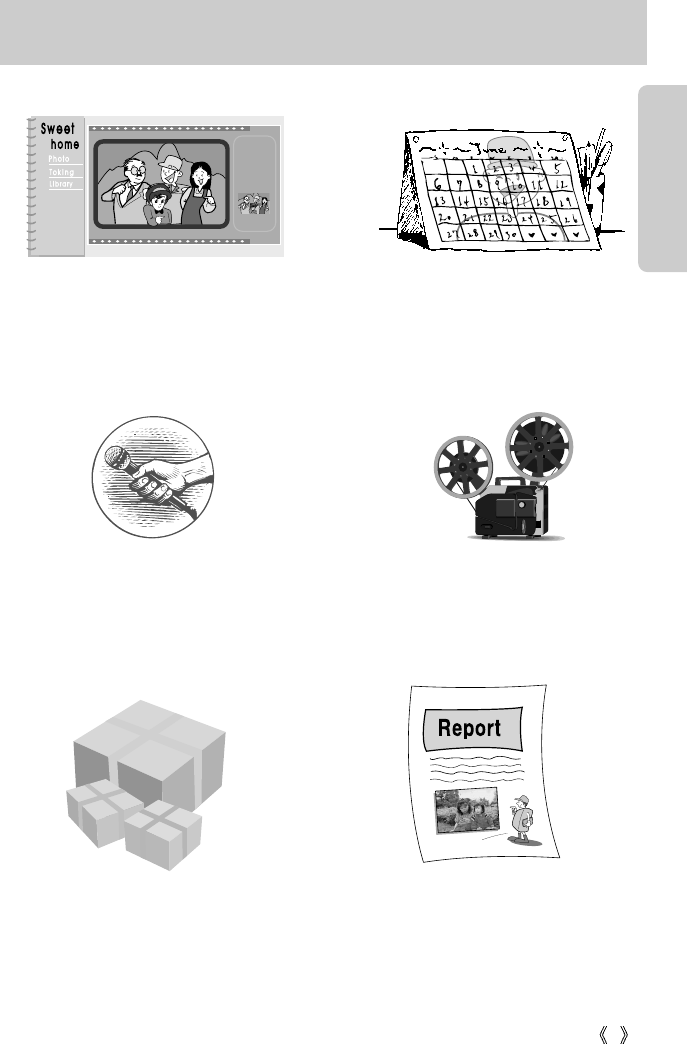
9
This digital camera can be used for
Inserting images directly into any
electronic document.
Taking a favourite image and creating
your own personalized calendar with it.
You can even create your own unique gift wrap
paper by using your digital images.
Creation of a digital photo album.
Recording your voice.
(refer to page 23) Recording a movie clip.
(refer to page 24)
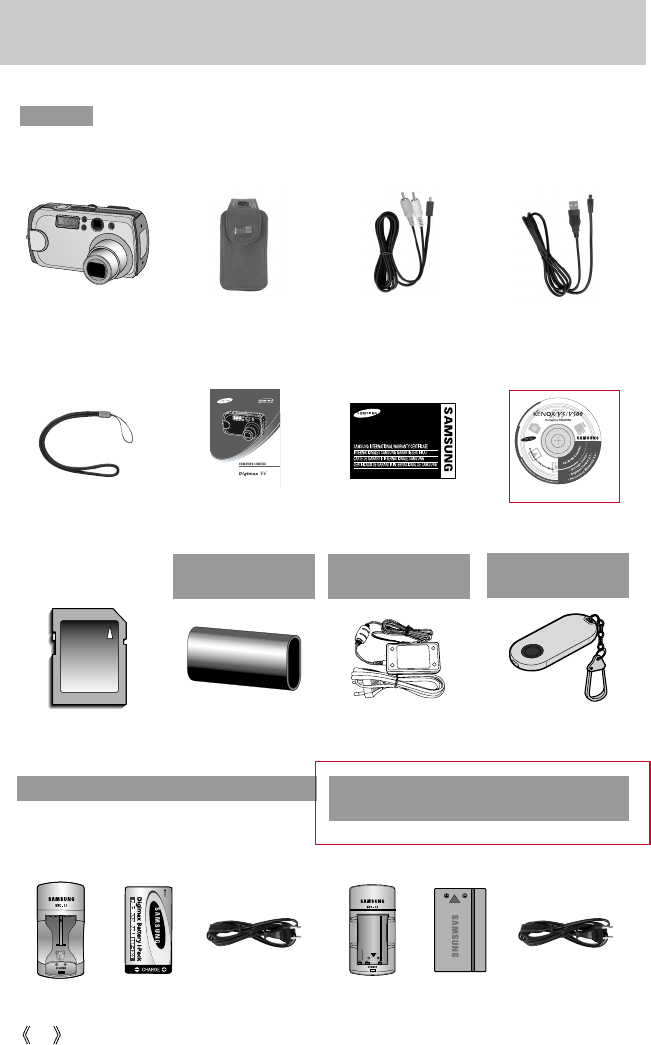
10
Manufacturer's contents
Please check that you have the correct contents before using this product.
marked contents are optional.
Digital Camera USB cableAV cablePouch
Camera strap Software CDProduct warrantyUser manual
SD memory card CR-V3 battery AC adapter
(SAC-51, DC 5V) Remote control
Battery
charger
Rechargeable
battery
AC cord
Battery
charger(SBC-L2)
Rechargeable
battery
AC cord
Digimax Battery I-Pack : SBP-1303 KIT
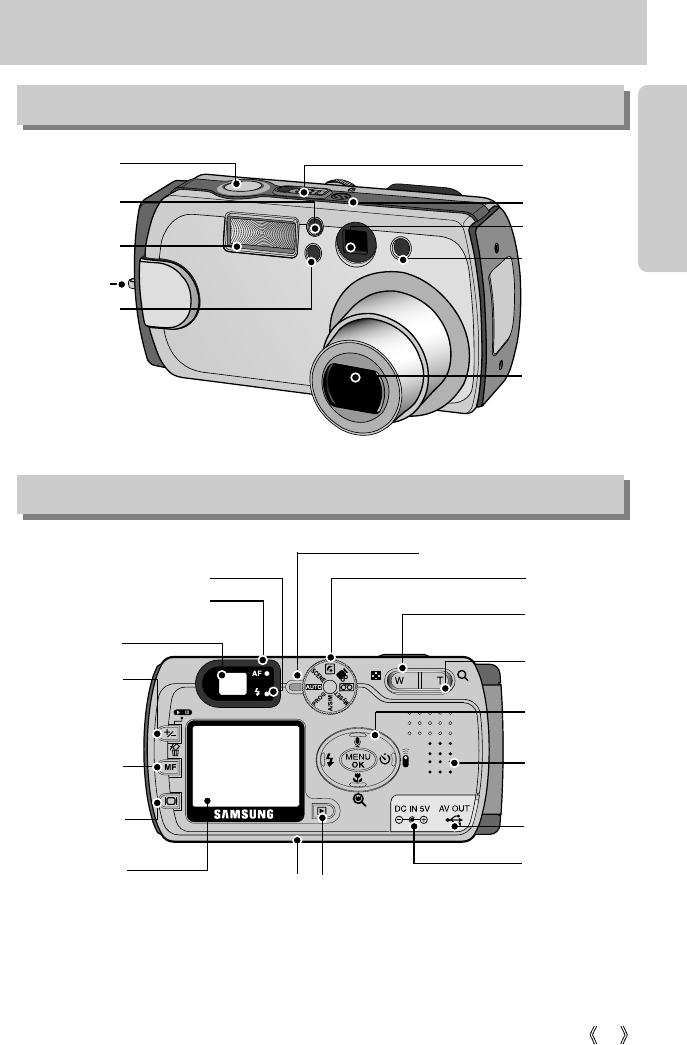
11
Identification of features
Front & Top
Back & Bottom
* When using the digital zoom to take a picture, the composition of the picture may be different
depending on whether you are using the LCD monitor or the viewfinder. The picture will be
taken in the composition of the picture as it appears on the LCD monitor.
Viewfinder
Autofocus indicator lamp(Green)
Flash indicator lamp(Red) Mode dial
Mode dial lamp(Green)
Zoom W button
(Thumbnail)
5-function button
Zoom T button
(Digital zoom)
Speaker
LCD monitor Tripod socket PLAY mode button
DC input
connection point
USB/ AV connection
terminal
+&-/PLAY &
PAUSE button
MF / DELETE
button
LCD button
Shutter button
Flash light
amount sensor
Remote
control sensor
Power switch
Microphone
Self-timer lamp
Viewfinder
Lens
Flash
Strap eyelet
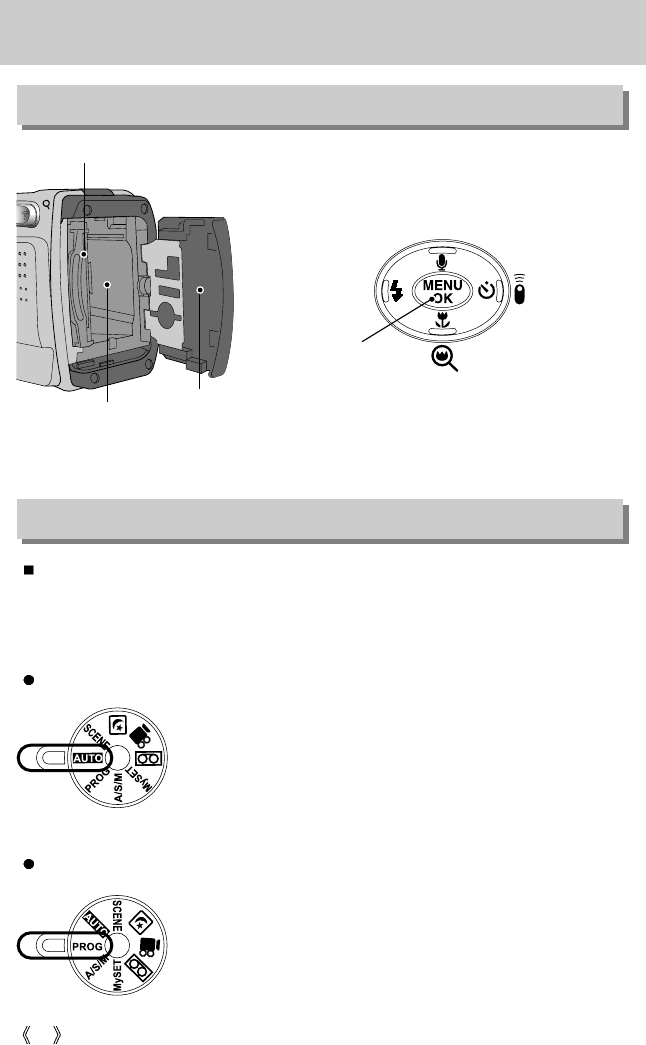
12
Identification of features
PROGRAM mode
Please select this mode for quick and easy picture taking
with minimal user interaction.
Selecting the automatic mode will configure the camera with
optimal settings. You can still manually configure all
functions except the iris and shutter speed.
AUTO mode
You can select the desired working mode by using the mode dial located on the back of the
camera. This digital camera has 8 recording modes. These are listed below.
Side/ 5-function button
Mode dial
Battery chamber
Memory card slot
Battery chamber
cover
FLASH/ LEFT
button
MENU/ OK
button
MACRO / SUPER MACRO /
DOWN button
SELF-TIMER/
RIGHT button
Voice memo/ UP button
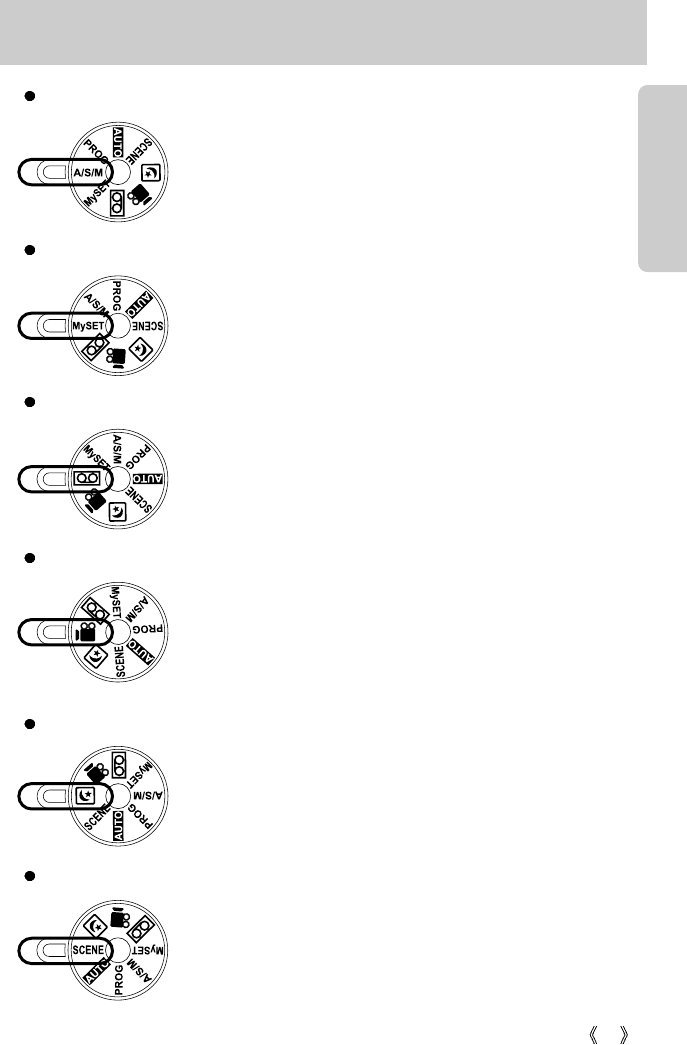
13
Identification of features
Aperture priority / Shutter priority / Manual mode
The Aperture and Shutter can be set manually in the A/ S/ M
mode.
A/S/M mode
This mode allows users to save frequently used shooting
settings for later use.
MySET mode
A voice recording can be recorded for as long as the available
recording time of the memory capacity allows.(Max : 1 hour)
Voice recording file type : *.wav
VOICE RECORDING mode
A movie clip can be recorded for as long as the available
recording time of the memory capacity allows.
- Image size : 640X480, 320X240(user selectable)
- Movie clip file type : *.avi
MOVIE CLIP mode
Use the menu to easily configure optimal settings for a variety
of shooting situations including portrait, children, landscape,
close-up, sunset, dawn, backlight, fireworks, beach scenes
and snowscape.
SCENE mode
This mode is used at night or against a dark background.
NIGHT SCENE mode
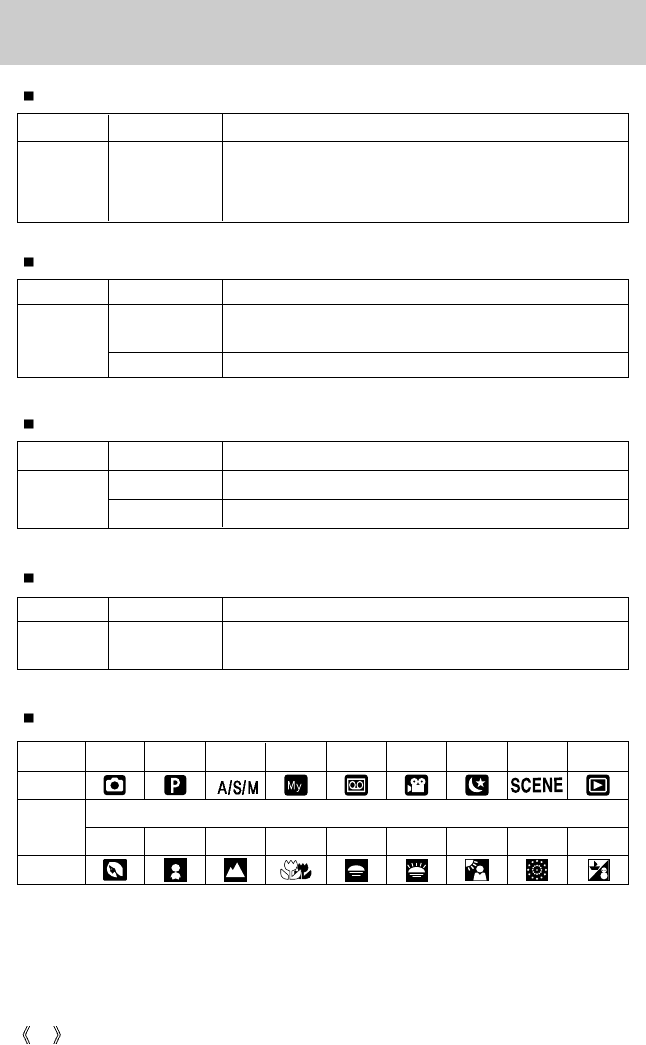
14
Identification of features
Self-timer lamp (Based on 10-second Self-timer; see p. 35)
Color Status Camera Status
Blinking
- For the first 7 seconds, the LED blinks at 1second intervals.
- For the final 3 seconds, the LED blinks quickly at 0.25-second
intervals.
Red
Color Status Camera Status
Blinking
Recording Mode (lightly press the shutter button): Not focused
PC Mode: Transmitting Data
Recording Mode (lightly press the shutter button): Focused
On
Green
Color Status Camera Status
Blinking Flash in the process of charging
Flash ready
ON
Red
MODE
Icon
Icon
MODE
SCENE
AUTO
PROGRAM
MySET
VOICE RECORDING
MOVIE CLIP
NIGHT SCENE
SCENE PLAY
CHILDREN
LANDSCAPE
CLOSE-UP
SUNSET
DAWN
BACKLIGHT
FIREWORKS
BEACH&SNOW
Auto focus indicator lamp
Color Status Camera Status
ON
Turned off the LCD with the LCD button.
PC Mode: When the USB cable is inserted.
Green
Mode dial lamp
Flash indicator lamp
Mode icons
A/S/M
PORTRAIT
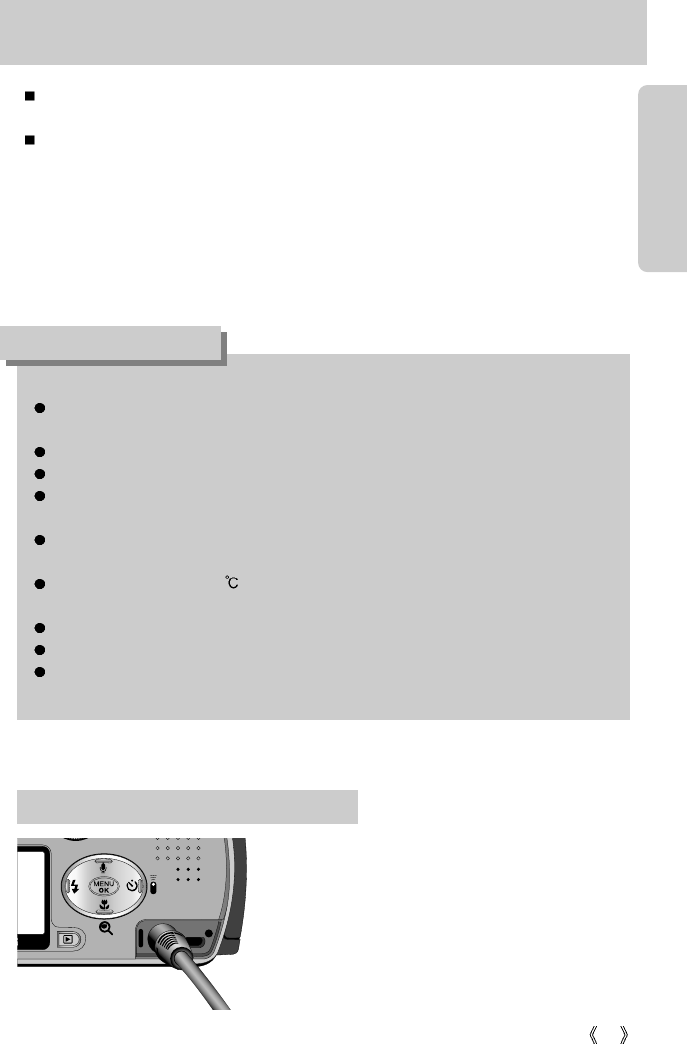
15
Connecting to a Power Source
Important information about battery usage
It is easy to buy alkaline batteries. However, the duration for using batteries varies in
accordance with the battery manufacturer or the photographic conditions.
When the camera is not used, turn off the camera power.
Do not recharge the non rechargeable batteries. It may cause an explosion.
Please remove the batteries if the camera will not be used for long periods. Batteries can
lose power over time and are prone to leaking if kept inside the camera.
We recommend high capacity ALKALINE batteries as manganese batteries cannot
deliver sufficient power.
Low temperatures (below 0 ) can affect the performance of the batteries and you may
experience reduced battery life.
Batteries will usually recover at normal temperatures.
Do not use old and new batteries at the same time.
During extended use of the camera, the camera body may become warm.
This is perfectly normal.
INFORMATION
If you have access to a mains supply, using an AC
Adapter (5V 2.0A) allows the camera to be used for
long periods of time.
Plug the adapter into the connection point (DC IN 5V)
on the camera.
Remove the batteries from the camera when using an
AC adapter.
Using the AC power adapter (5V 2.0A)
There are two ways in which to provide the camera with power. You can use batteries or
alternatively, you can use an AC(100 ~ 250V) Adapter (DC 5V 2.0A).
We recommend using batteries for a digital camera (Within a year from the date of
manufacture). The batteries are listed below.
Non rechargeable batteries : AA type - Alkaline, Ni-Mn, Ni-Zn, Lithium
CR-V3 type - Lithium
Rechargeable batteries : AA type - Ni-MH, Ni-Cd (over 1000mAh)
CR-V3 type - SBP-1303
Manufacturer’s rechargeable battery: SLB-1437
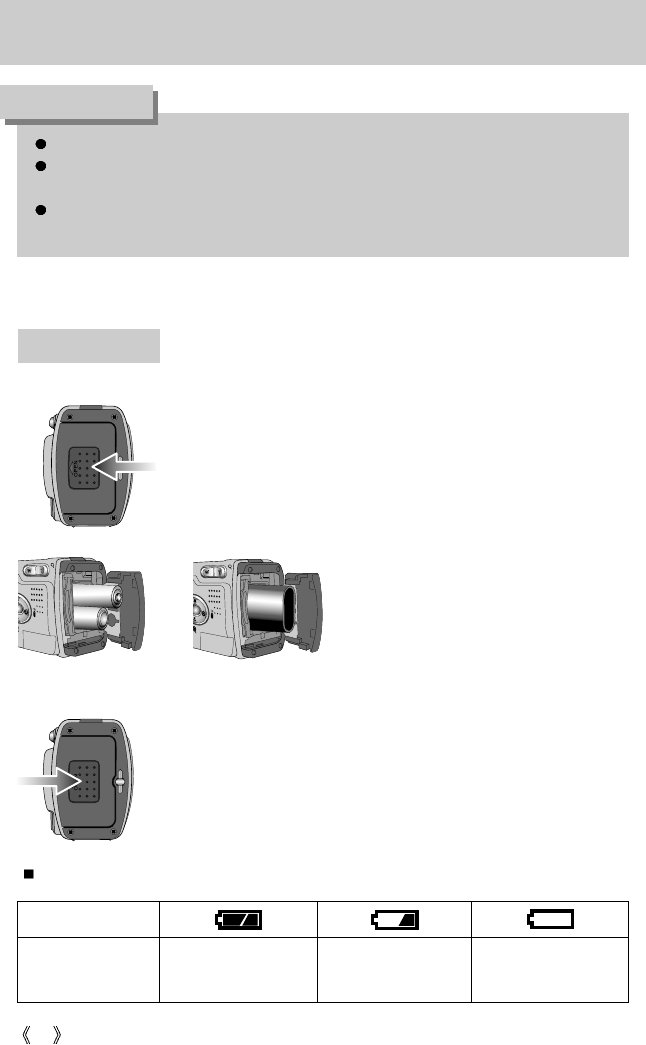
16
Connecting to a Power Source
Battery status
Battery indicator
The batteries are fully
charged. Prepare new batteries.
There is no battery capacity.
Replace with new batteries.
There are 3 indicators for battery condition that are displayed on the LCD monitor.
3. To close the battery chamber cover, push it until it clicks.
2. Insert the batteries taking note of the
polarity (+ / -).
1. Open the battery chamber cover by pushing in the direction of the
arrow.
: If the camera does not turn on after you have inserted batteries,
please check whether the batteries are inserted with the correct
polarity(+/-).
Using the batteries
[ Inserting the AA type battery ]
[ Inserting the CR-V3 type battery ]
Always turn off the power before taking the AC adapter out of the mains supply.
As with all mains powered devices, safety is important. Ensure that neither the camera
nor adapter comes into contact with water or metallic materials.
Please ensure that you use an AC adapter (5V 2.0A) with the correct specification for the
camera. Failure to do so may affect your warranty.
DANGER

17
Instructions on how to use the memory card
Be sure to format the memory card (see p. 81) if you are using a newly purchased memory
for the first time, if it contains data that the camera cannot recognize, or if it contains images
captured with a different camera.
Turn off the camera power whenever the memory card is being inserted or removed.
Repeated use of the memory card will eventually reduce the memory card’s performance.
Should this be the case, you will need to purchase a new memory card.
Wear and tear on the memory card is not covered by the Samsung warranty.
The memory card is an electronic precision device.
Do not bend, drop or subject the memory card to any heavy impact.
Do not store the memory card in an environment with strong electronic or magnetic fields,
e.g. near loud speakers or TV receivers.
Please do not use or store in an environment where there are extremes in temperature.
Do not allow the memory card to become dirty or to come into contact with any liquid.
Should this happen, clean the memory card with a soft cloth.
Please keep the memory card in its case when not in use.
During and after periods of extended use, you may notice that the memory card is warm.
This is perfectly normal.
Do not use a memory card that is used in another digital camera or memory card reader.
Do not use a memory card formatted by another digital camera or memory card reader.
Maintenance of the memory card
If the memory card is subjected to any of the following, the recorded data may become
corrupted :
- When the memory card is used incorrectly.
- If the power is switched off or the memory card is removed while recording, deleting
(formatting) or reading.
Samsung cannot be held responsible for lost data.
It is advisable to copy important data onto other media as back-up e.g. floppy disks, hard
disks, CD etc.
If there is insufficient memory available : If you press the shutter button for the shot, a [CARD
FULL !] message will appear and the camera will not operate. To optimize the amount of
memory in the camera, replace the memory card or delete unnecessary images stored on
the memory.
Preserving the memory card data
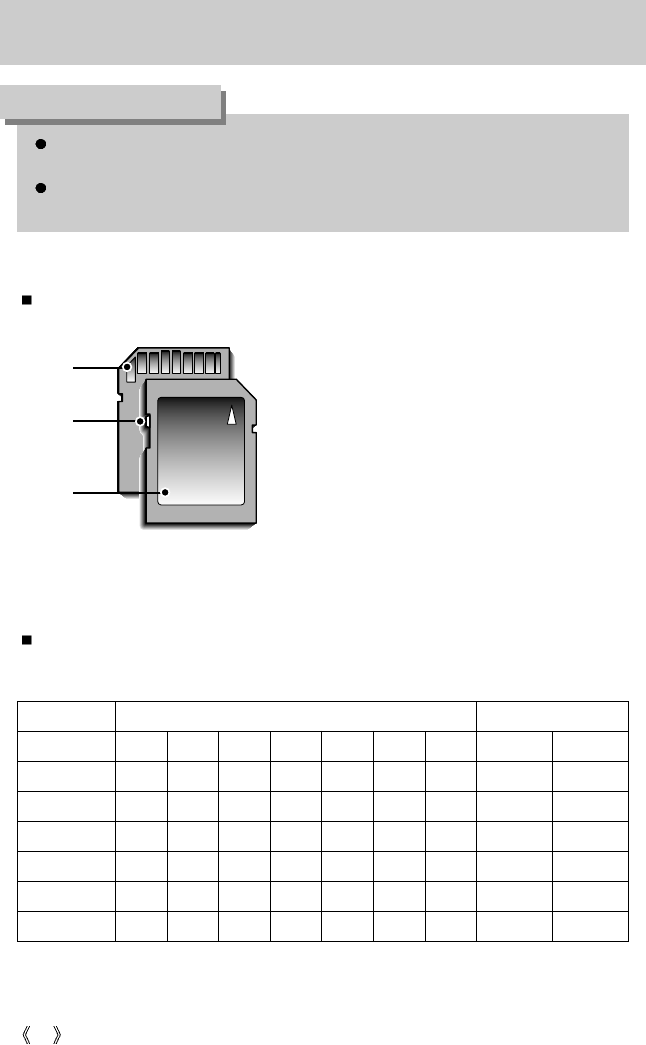
18
Instructions on how to use the memory card
If you open the battery chamber cover when the camera power is turned on, the power
will turn off automatically.
Don’t remove the memory card when the Auto focus lamp(Green) is blinking as this may
cause damage to data in the memory card.
INFORMATION
[ SD(Secure Digital) memory card ]
Write
protect
switch
Label
Card
pins
The camera can use SD Memory Cards and MMC (Multi Media Card).
The SD memory card has a write protect switch
that prevents image files from being deleted or
formatted.
By sliding the switch to the bottom of the SD
memory card, the data will be protected. By
sliding the switch to the top of the SD memory
card, the data protection will be canceled. Slide
the switch to the top of the SD memory card
before taking a picture.
When using a 32MB SD memory card, the specified shooting capacity will be as follows.
(These figures are intended as an indication of expected performance). These figures are
approximate as image capacities can be affected by variables such as subject matter.
Mode
Quality/Size
2816 2560 2272 2048 1600 1024 640 640x480 320x240
TIFF
122351227 - -
Super fine
9 11 14 17 28 64 129 - -
Fine
18 22 28 33 53 106 201 - -
Normal
26 32 40 49 75 139 227 - -
30FPS
-------
29SEC 107SEC
15FPS
-------
45SEC 154SEC
STILL IMAGE mode MOVIE CLIP mode
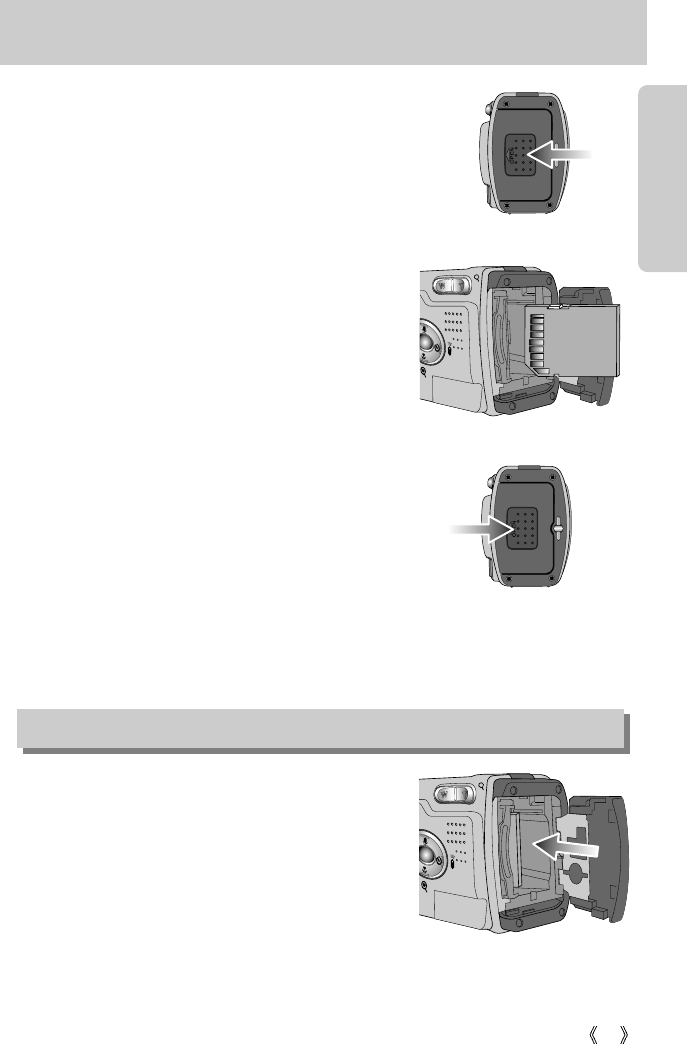
19
Inserting the memory card
1. Slide the power switch to turn the power off.
Open the battery chamber cover and press the memory
card as shown in the image and release.
2. Remove the memory card and close the battery chamber
cover.
3. To close, push the battery chamber cover until you hear a
click. If the memory card does not slide in smoothly, do not
attempt to insert it by force. Check the direction of insertion,
and then insert it correctly.
Do not insert the memory card the wrong way round. Doing
so may damage the memory card slot.
2. Have the front of the memory card facing toward the front of
the camera (lens) and the card pins toward the back of the
camera (LCD monitor), and then push the memory card
into the card slot until you hear a click.
1. Slide the power switch to turn the power off. Open the
battery chamber cover while pushing it in the direction of
the arrow.
Removing the memory card
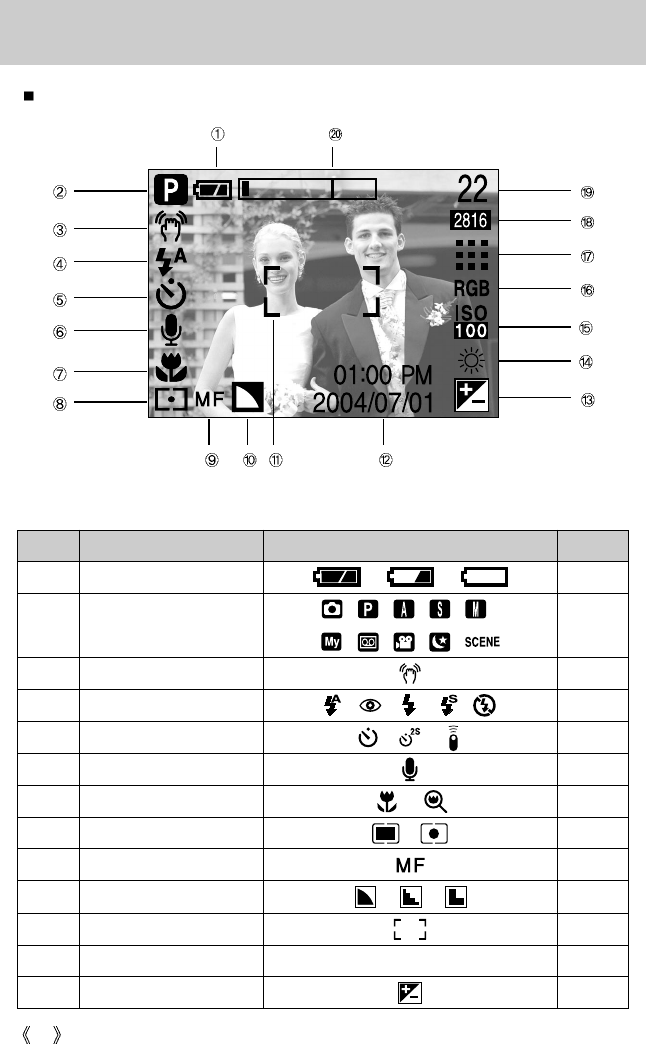
20
LCD monitor indicator
[ Image & Full Status ]
No. Description Icons Page
1 Battery p.16
3 Camera shake warning p.26
4 Flash p.33
5 Self-timer p.35
6 Voice memo p.29
7 Macro p.30
8 Metering p.50
9 Manual focus p.38
10 Sharpness p.52
11 Auto focus frame
12 Date/ Time 2004/07/01 01:00 PM p.82
13 Exposure compensation p.41
The LCD monitor displays information about the shooting functions and selections.
Recording mode
2
p.12~13
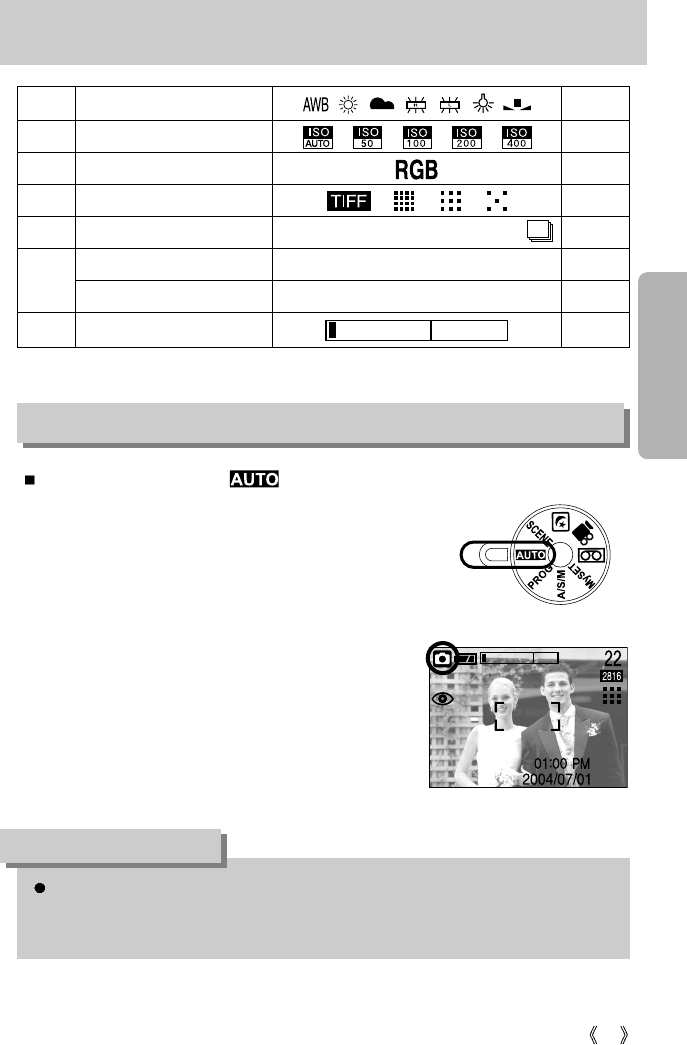
21
LCD monitor indicator
14 White Balance p.42
15 ISO p.42
16 RGB p.41
17 Image quality p.49
18
Image size/ Continuous shot 2816, 2560, 2272, 2048, 1600, 1024, 640/ 0
p.48
Number of available shots remaining
22
Remaining time (Movie clip/ Voice recording)
00:01:30/ 01:00:00
20
Optical/ Digital Zoom rate
Starting the recording mode
1. Insert the batteries.(p.16) Insert the batteries taking note
of the polarity (+ / -).
2. Insert the memory card (p.19).
3. Close the battery chamber cover.
4. Slide the power switch to turn on the camera.
(If the date/time that is displayed on the LCD monitor is
incorrect, reset the date/time before taking a picture.)
5. Select the AUTO mode by rotating the mode dial.
6. Point the camera towards the subject and compose the
image by using either the viewfinder or LCD monitor.
7. Press the shutter button to capture an image.
How to use the AUTO mode ( )
[ AUTO mode ]
19
If the auto focus frame turns to red when you press the shutter button down half way, it
means that the camera cannot focus on the subject. Should this be the case, the camera
is unable to capture an image clearly.
INFORMATION
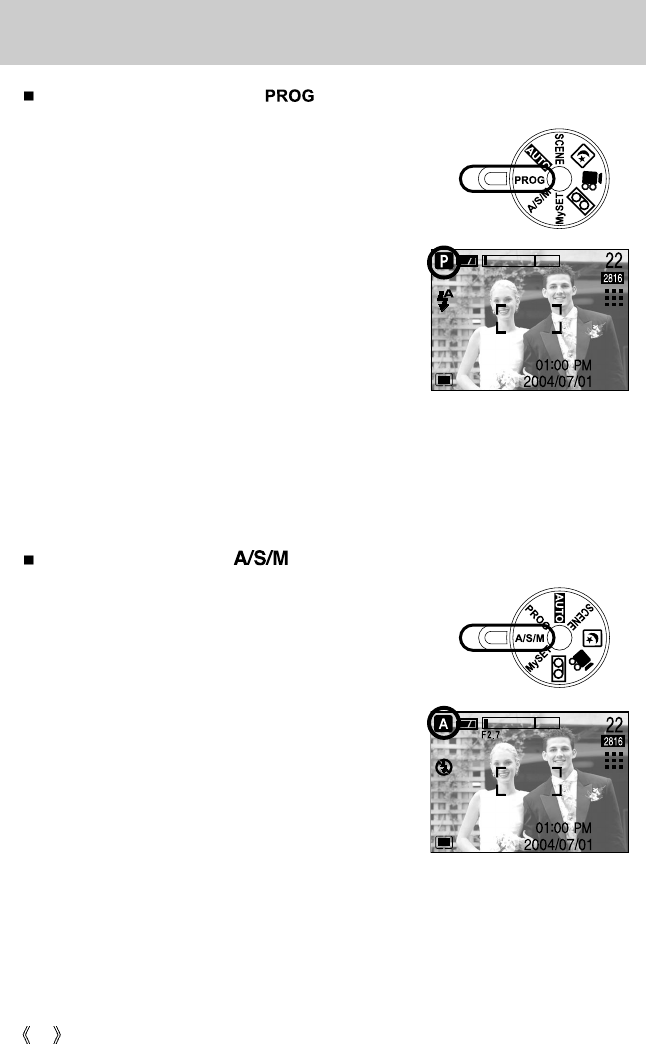
22
How to use the PROGRAM mode ( )
Selecting the automatic mode will configure the camera
with optimal settings. You can still manually configure all
functions except the iris and shutter speed.
Steps from 1-4 are the same as those for AUTO mode.
5. Select the PROGRAM mode by rotating the mode dial.
6. Press the menu button to configure advanced functions
such as image size (p.48), quality (p.49), metering (p.50),
number of pictures in continuous shooting (p.50), picture
effects (p.51), sharpness (p.52).
7. Point the camera towards the subject and compose the
image by using either the viewfinder or LCD monitor.
8. Press the shutter button to capture an image.
Starting the recording mode
[ PROGRAM mode ]
How to use the A/S/M mode ( )
In this mode you can select the shutter speed or aperture
value to your preference. Steps from 1-4 are the same as
those for AUTO mode.
5. Select the A/S/M mode by rotating the mode dial.
6. Press the menu button and select the [ASM] menu tab.
7. Use the Up/Down buttons to select A (Aperture priority),
S (shutter priority), or M (Manual mode).
Press the OK button to confirm.
* Please see page 40 for details on Aperture and Shutter
speed setting
8. Point the camera towards the subject and compose the
image by using either the viewfinder or LCD monitor.
9. Press the shutter button to capture an image.
[ A/S/M mode ]
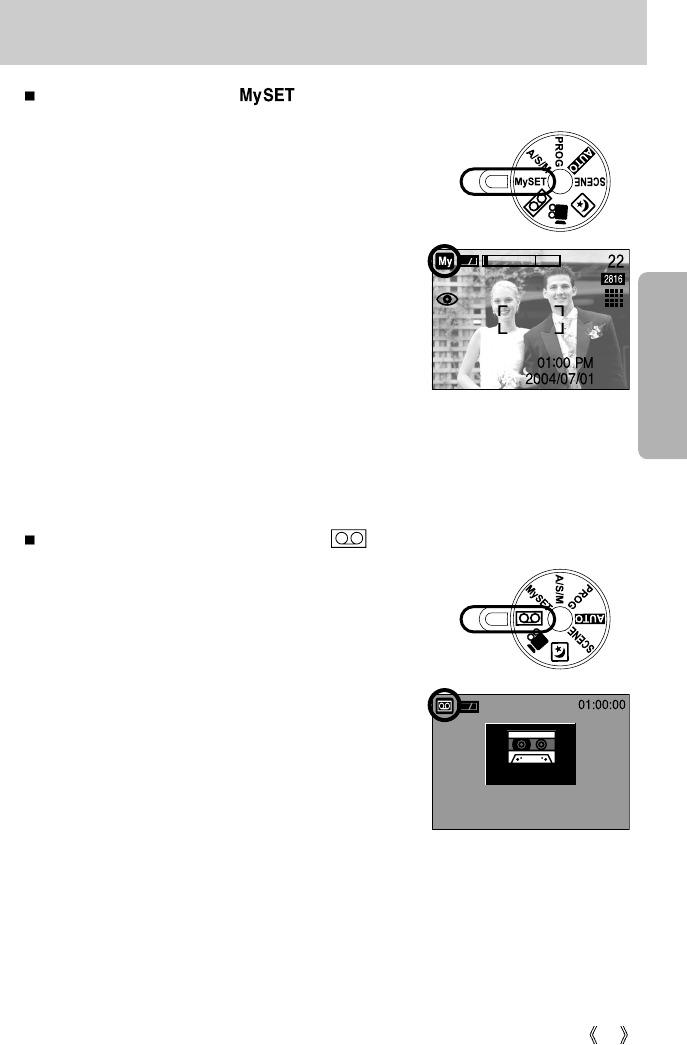
23
Starting the recording mode
How to use the MySET mode ( )
This mode allows users to save frequently used shooting settings
for later use. Steps from 1-4 are the same as those for AUTO
mode.
5. Select the MySET mode by rotating the mode dial.
6. You can use the menus that appear when you press camera
and menu buttons to change the desired camera
functions.
The last changed function(s) will automatically be saved
as MySET mode.
7. If you rotate the Mode Dial to MySET mode while in
another camera operation mode, the camera settings
will switch to the settings you changed in Step 6.
8. Point the camera towards the subject and compose the
image by using either the viewfinder or LCD monitor.
9. Press the shutter button to capture an image.
* Voice memo, self-timer, and remote controller configurations cannot be saved.
[ MySET mode ]
Steps from 1-4 are the same as those for AUTO mode.
5. Select the VOICE RECORDING mode by rotating the
mode dial.
6. Press the shutter button to record a voice.
- Press the shutter button once and voice is recorded for
as long as the available recording time(Max : 1 hour)
allows. The recording time will be displayed on the LCD
monitor. Voice will still be recorded if the shutter button is
released.
- If you wish to stop recording, press the shutter button
again.
- File type : *.wav
* A distance of 40cm between you and the camera
(microphone) is the best distance to record sound.
* The auto focus indicator lamp(Green) blinks during voice
recording.
[ VOICE RECORDING mode ]
START:SHUTTER
STANDBY
How to use the VOICE RECORDING mode ( )
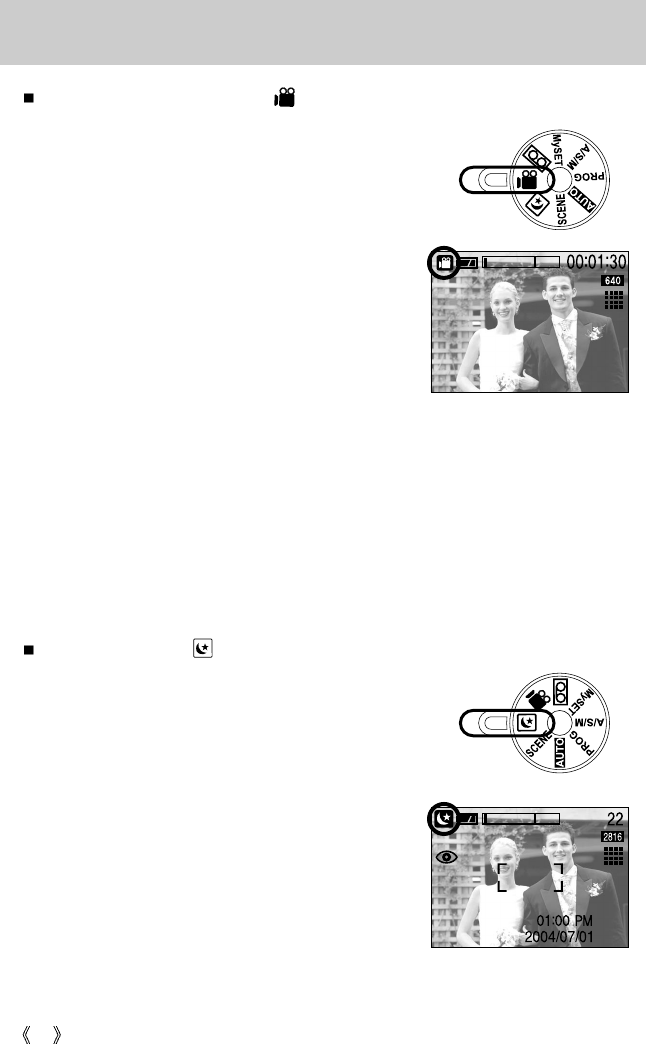
24
NIGHT SCENE mode ( )
This mode is used at night or against a dark background.
Configure the shutter speed by zoom scale (Long Time
shutter) with the +/- button.
Please see page 44 for a detailed description for Long
Time shutter.
Starting the recording mode
How to use the MOVIE CLIP mode ( )
Steps from 1-4 are the same as those for AUTO mode.
5. Select the MOVIE CLIP mode by rotating the mode dial.
6. The MOVIE CLIP mode icon and available recording time will
display on the LCD monitor.
7. Point the camera towards the subject and compose the image
by using either the viewfinder or LCD monitor. Press the
shutter button and movie clips are recorded for as long
as the available recording time.
Movie clips will still be recorded if the shutter button is
released. The auto focus lamp(green) will blink during
the movie clip recording.
8. If you wish to stop recording, press the shutter button
again.
* Image size and type are listed below.
- Image size : 640x480, 320 x 240(Selectable)
- File type : *.avi
[ MOVIE CLIP mode ]
STANDBY
[ NIGHT SCENE mode ]
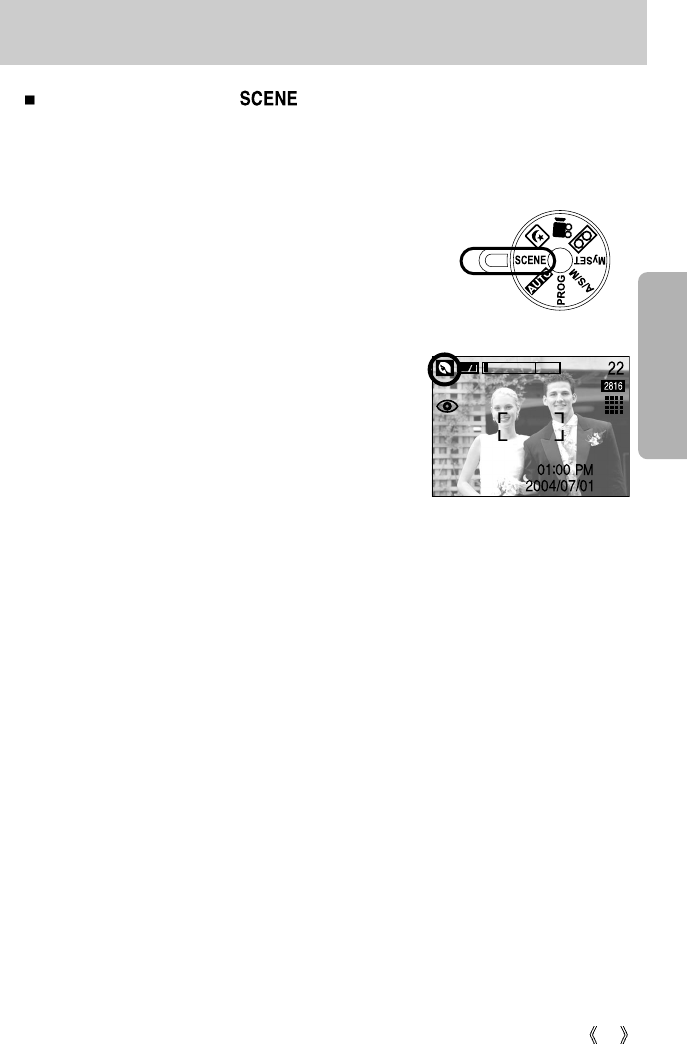
25
Starting the recording mode
How to use the SCENE mode ( )
Use the menu to easily configure optimal settings for a variety of shooting situations including
portrait, children, landscape, close-up, sunset, dawn, backlight, fireworks, beach scenes and
snowscape.
Steps from 1-4 are the same as those for AUTO mode.
5. Select the SCENE mode by rotating the mode dial.
6. Press the menu button and use the Left/Right buttons to select
the [SCENE] menu tab.
7. Use the Up/Down buttons to select the desired submenu in
Scene mode. Press the OK button to confirm.
Please see page 53 for detailed descriptions for each screen.
8. The current scene icon is displayed at the top left of the
LCD.
9. Point the camera towards the subject and compose the
image by using either the viewfinder or LCD monitor.
10. Press the shutter button to capture an image.
[ SCENE mode ]
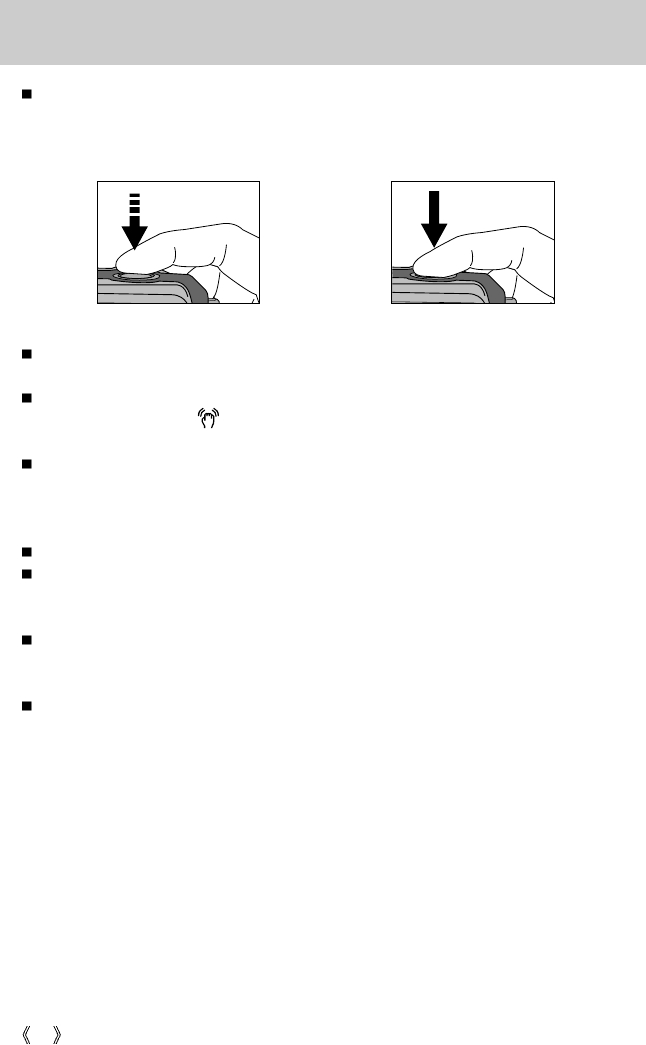
26
Things to Watch Out for When Taking Pictures
Pressing the shutter button down half way
Lightly press the shutter button to confirm focus and flash battery charge. (See page 14)
Press the shutter button all way down to take the picture.
The available recording time may vary depending on shooting conditions and camera
settings.
When the Flash Off or Slow synchro mode is selected in a low lighting condition, the camera
shake warning indicator ( ) may appear on the LCD monitor. In this case, use a tripod,
support the camera on a solid surface or change the flash mode to flash shot mode.
Backlight compensated shots: When taking an outdoor shot, avoid facing the sun, as the
image may be dark because of the strong backlight. To take a picture against the sun, please
use the [BACKLIGHT] in the scene shooting mode (see page 53), Fill-in flash (see page 33),
Spot metering (see page 50), or Exposure compensation (see page 43).
Avoid obstructing the lens or the flash when you capture an image.
As there can be some differences between what is seen through the Viewfinder and the
resulting image when taken at a range closer than 1.5m, it is recommended that you use the
LCD monitor to compose these shots.
Using the LCD monitor extensively will drain the batteries.
We recommend turning off the LCD monitor and using the optical viewfinder as often as
possible in order to extend battery life.
Under certain conditions the auto focus system may not perform as expected.
- When photographing a subject that has little contrast.
- If the subject is highly reflective or shiny.
- If the subject is moving at high speed.
- When there is strong reflected light, or when the background is very bright.
- When the subject matter has only horizontal lines or the subject is very narrow (such as a
stick or flagpole).
- When the surroundings are dark
[ Lightly press the shutter button ] [ Press the shutter button ]
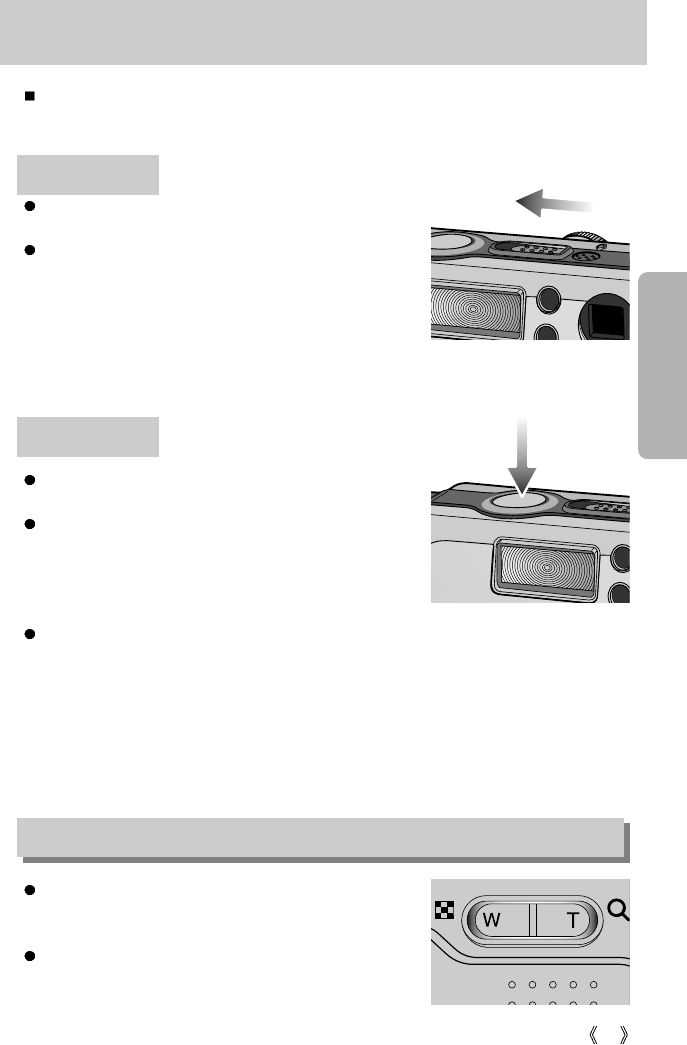
27
Using the camera buttons to adjust the camera
The RECORDING(AUTO, PROGRAM, A/S/M, MySET, VOICE RECORDING, MOVIE CLIP,
NIGHT SCENE , SCENE) mode function can be set up by using the camera buttons.
Used for turning the camera’s power on / off.
Slide the power switch to turn the power on
If there is no operation during the specified time, the
camera’s power will be turned off automatically to save
battery life. Slide the power switch and hold it for 3 seconds
to turn the power on without the ‘start’ sound.
POWER switch
Used for taking an image or recording voice in the
RECORDING mode.
In MOVIE CLIP mode : Pressing the shutter button down
fully starts the process for recording a movie clip. Press the
shutter button once and the movie clip is recorded for as long
as the available recording time in the memory allows. If you
wish to stop recording, press the shutter button again.
In STILL IMAGE mode
Pressing the shutter button down halfway activates the auto focus and checks the condition
of the flash.
Pressing the shutter down fully takes the image and stores the relevant data regarding the
shot. If you select voice memo recording, the recording will start after the camera has finished
storing the image data.
SHUTTER button
Press the W/T buttons to browse between menu tabs in 5
steps while using a menu screen in the Program, A/S/M, or
MySET shooting modes.
If the menu is not displayed, this button works as the
OPTICAL ZOOM or DIGITAL ZOOM button.
ZOOM W/T button
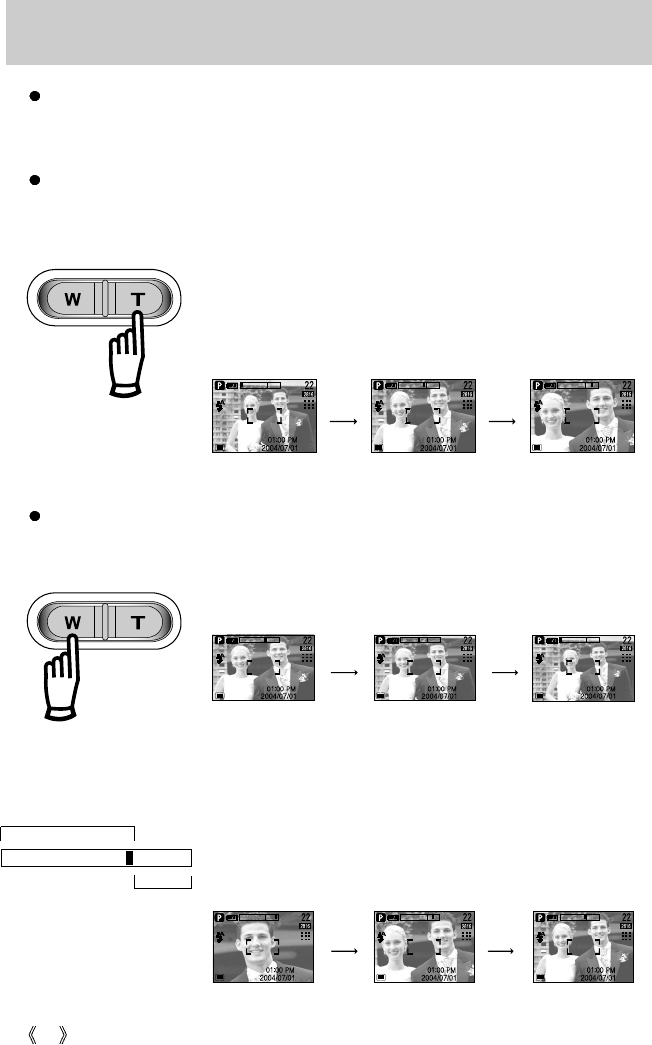
28
ZOOM W/T button
This camera has a 3X optical zoom and a 4X digital zoom function. Using both will offer a
total zoom ratio of 12X.
TELE Zoom
Optical zoom TELE : Pressing the ZOOM T button. This will zoom into the subject i.e.
the subject will appear nearer.
Digital zoom TELE : When the maximum (3X) optical zoom is selected, pressing the
ZOOM T button activates the digital zoom software. Releasing
ZOOM T button stops the digital zooming at the required setting.
Once the maximum digital zoom (4X) is achieved, pressing the
ZOOM T button will have no effect.
[ WIDE zoom ] [ TELE zoom ] [ Digital zoom 2.0X ]
Pressing the
ZOOM T button
Pressing the
ZOOM T button
WIDE Zoom
Optical zoom WIDE : Pressing the ZOOM W button. This will zoom out from the subject
i.e. the subject will appear further away. Pressing the ZOOM W
button continuously will set the camera to its minimum zoom
setting i.e. the subject appears at its furthest from the camera.
Digital zoom WIDE : When the digital zoom is in operation, pressing the ZOOM W
button will reduce the digital zooming in steps.
Releasing ZOOM W button stops digital zooming.
Pressing the ZOOM W button will reduce the digital zoom and
then it will continue to reduce the optical zoom until the minimum
setting is reached.
[ TELE zoom ]
[ Optical zoom 2X ]
[ WIDE zoom ]
Pressing the
ZOOM W button Pressing the
ZOOM W button
[ Digital zoom 4.0X ] [ Digital zoom 2.0X ] [ TELE zoom ]
Pressing the
ZOOM W button
Pressing the
ZOOM W button
Optical zoom
Digital zoom
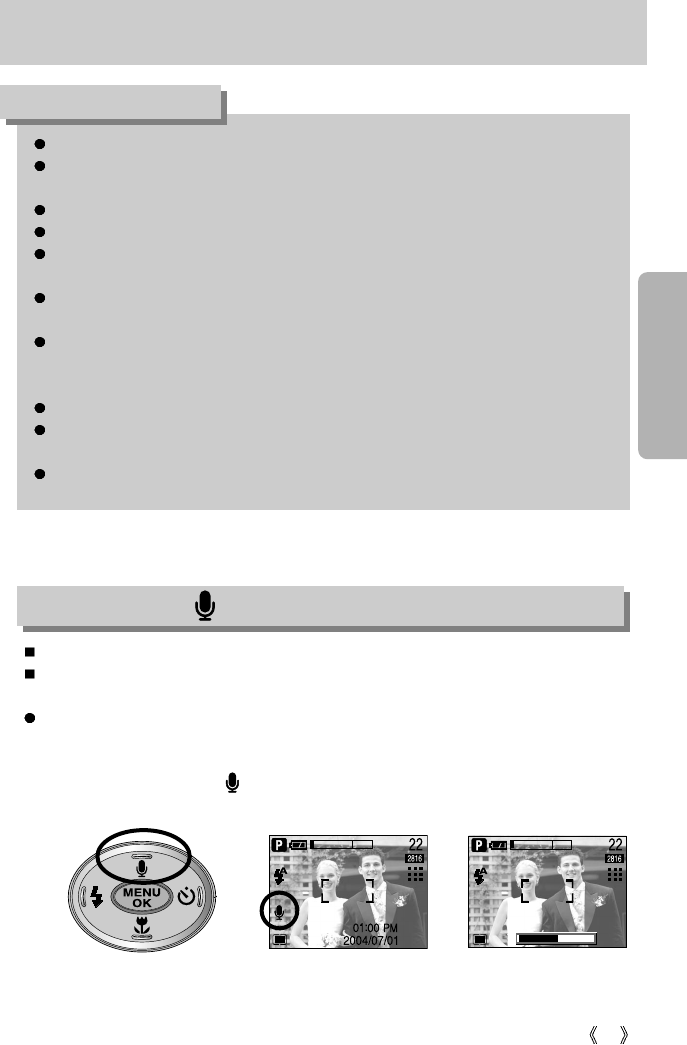
29
ZOOM W/T button
To use the digital zoom the LCD monitor has to be turned on.
Images taken using the digital zoom may take a little longer for the camera to process.
Allow time for this to take place.
Digital Zoom will not work in Night Scene mode.
You may notice a decrease in image quality when using the digital zoom.
You can record with digital zoom in MOVIE CLIP mode; you can use the digital zoom
while recording movie clips.
Do not use the zoom button while recording video, to avoid accidentally recording the
clicking sound. Please adjust the zoom before starting to record.
Take care not to touch the lens to avoid taking an unclear image and possibly causing
camera malfunction.
If the image is dim, turn the camera power off and on again to modify the lens position.
Take care not to press the lens as this may cause a camera malfunction.
When the camera is turned on, take care not to touch the camera’s moving lens parts as
this may cause the resulting image to be dim and unclear.
Take care not to touch the lens during zoom operation as this may cause damage.
INFORMATION
Voice memo( )/ UP button
While the menu is showing, press the UP button to move up the submenu cursor.
When the menu is not displayed on the LCD monitor, the UP button operates as the voice
memo button. You can add your voice-over to a stored still image.
Recording a voice memo
1. Rotate the MODE DIAL to select a RECORDING mode with the exception of MOVIE CLIP
and VOICE RECORDING modes.
2. Press the VOICE MEMO( ) button. If the voice memo indicator is displayed on the LCD
monitor, the setting is completed.
[ Recording Voice Memo ]
[ Preparing for Voice Memo ]
STOP:SHUTTER
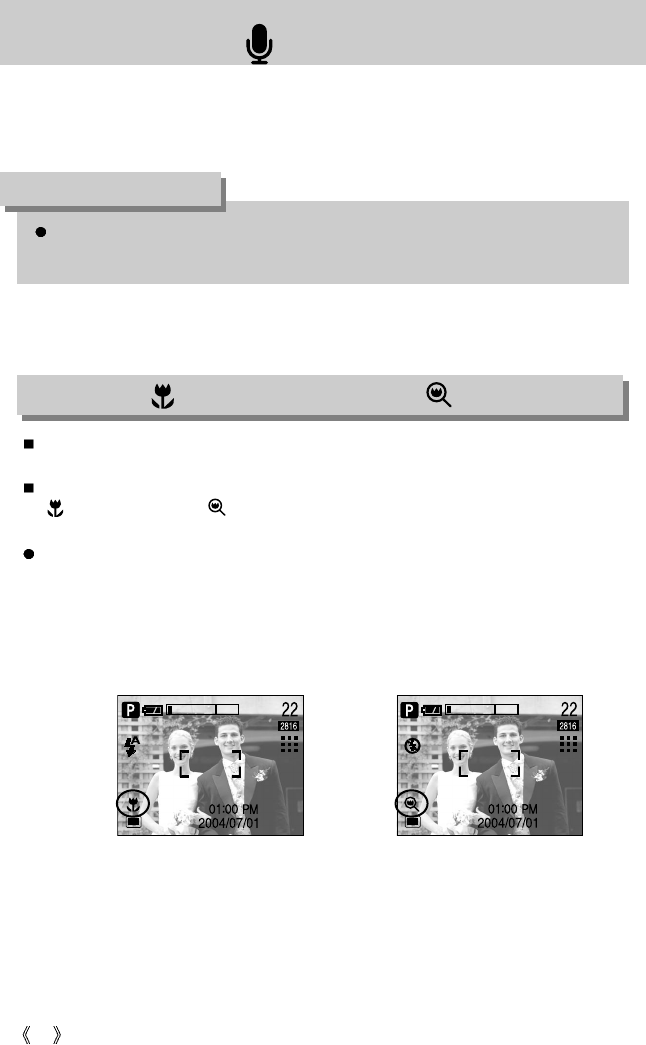
30
Voice memo( )/ UP button
3. Press the shutter button and take a picture. The picture is stored on the memory card.
4. Voice memo will be recorded for ten seconds from the moment the picture is stored.
In the middle of the sound recording, pressing the shutter button will stop the voice memo.
A distance of 40cm between you and the camera (microphone) is the best distance to
record sound.
INFORMATION
MACRO ( ) / SUPER MACRO ( ) button
When the menu is displayed on the LCD monitor, pressing the DOWN button makes the
menu cursor move down or changes the sub menu value.
When the menu is not displayed on the LCD monitor, the button operates as the MACRO
( ) / SUPER MACRO ( ) button. The photography range is 0.06m ~ 0.8m.
Selecting the MACRO/ SUPER MACRO
1. Rotate the mode dial to the RECORDING (except SCENE, NIGHT SCENE, VOICE
RECORDING) mode.
2. Press the MACRO button. The macro indicator will be displayed on the LCD monitor.
Press the MACRO button until the desired MACRO mode indicator displays on the LCD
monitor.
[ Selecting the macro mode ]
[ Selecting the super macro mode ]
3. Take a picture with the desired macro mode.
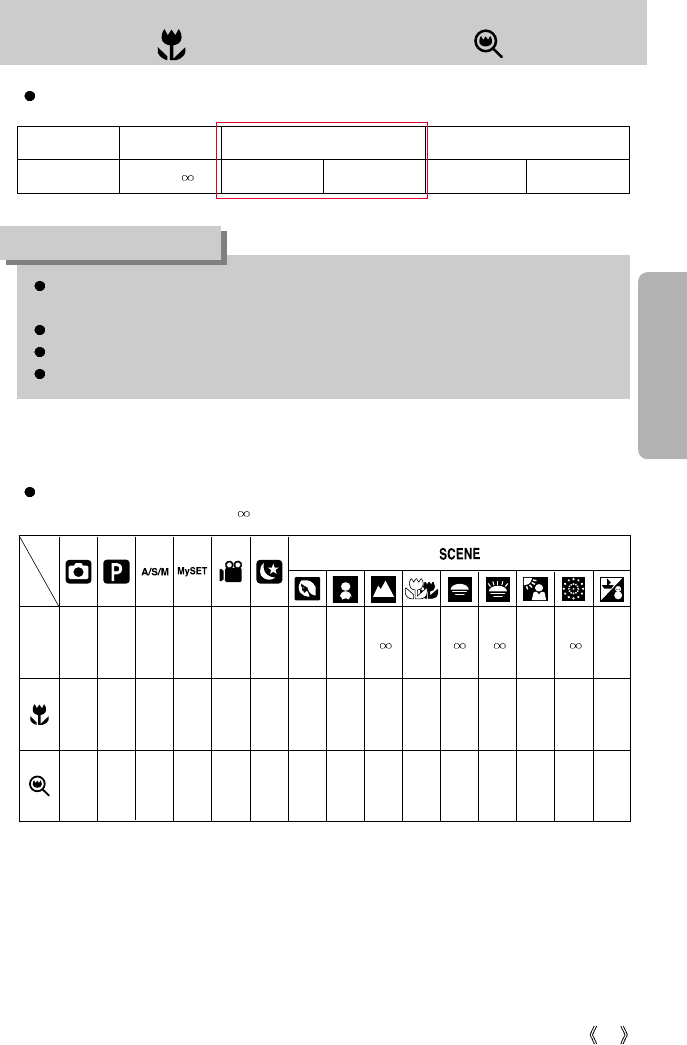
31
MACRO ( ) / SUPER MACRO ( ) button
When the macro or super macro mode is selected, It is possible that camera shake will
occur. If this is the case, use a tripod to eliminate this.
When super macro is selected, the flash mode is changed to Flash off automatically.
The super macro can be activated only in the wide zoom mode.
You cannot use the zoom(wide/tele) button in the super macro mode.
INFORMATION
Types of focus modes
Normal
Range 0.8 ~ W:0.3~0.8 T:0.3~0.8
W:0.06~0.3
T: X
Types of focus modes and focus ranges (W: WIDE, T: TELE)
Available focusing method, by recording mode.
(O: Available, X: Not available, : Infinite Focus)
Macro Super Macro
OOOOOOOO X O O
OOOOOXXXX XX X XX X
OOOOOXXXXOX XXX X
Auto
Unit : m
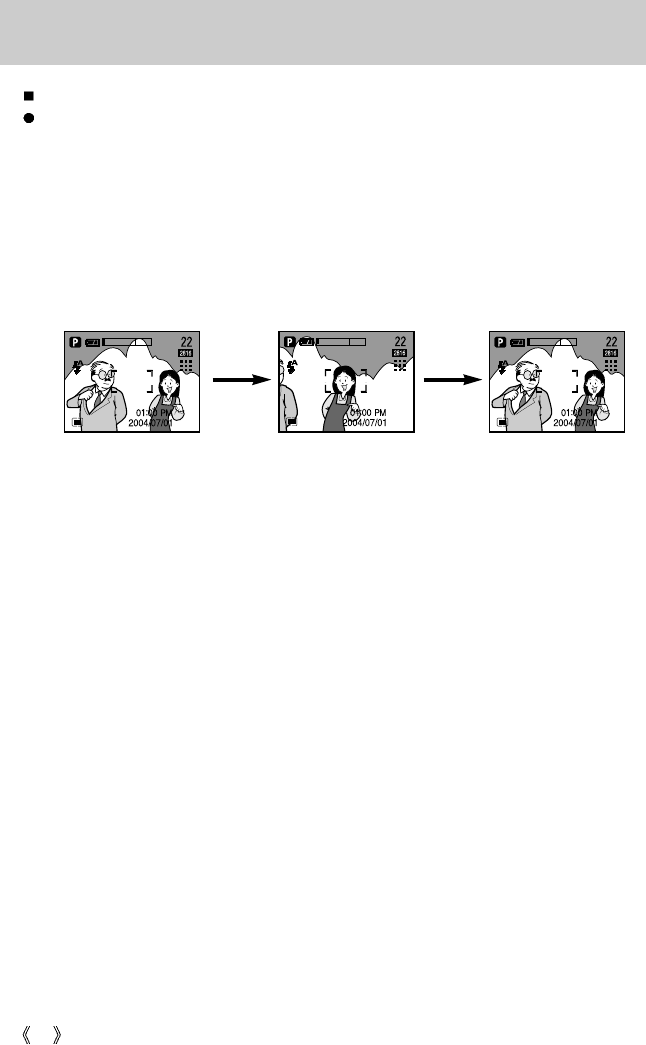
32
Focus lock
To focus on the subject positioned outside of the center, use the focus lock function.
Using the Focus Lock
1. Ensure the subject in the center of the autofocus frame.
2. Press the SHUTTER button halfway. When the green auto lights up, it means the camera
is focused on the subject. Be careful not to press the SHUTTER button all the way down to
avoid taking an unwanted pictured.
3. With the SHUTTER button still pressed down only halfway, move the camera to
recompose your picture as desired, and then press the SHUTTER button completely to
take the picture. If you release your finger from the SHUTTER button, the focus lock
function will be canceled.
[ The image to be captured ]
[ Press the SHUTTER button
halfway and focus on the subject ]
[ Recompose the picture and fully
depress the SHUTTER button ]
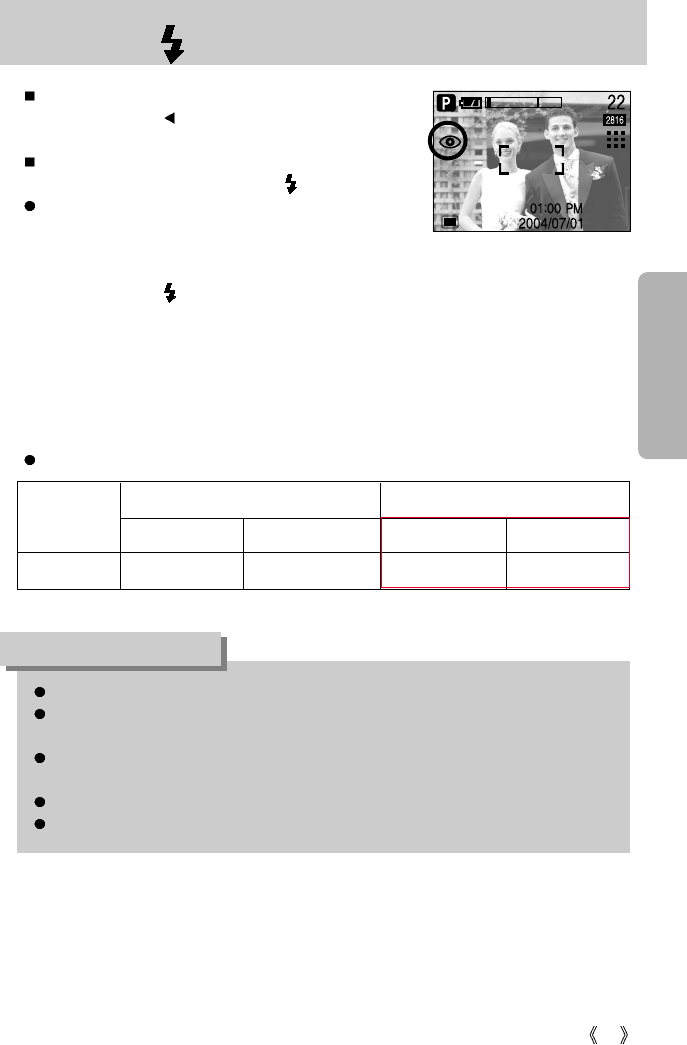
33
WIDE TELE WIDE TELE
0.8 ~ 3.0 0.8 ~ 2.0 0.3 ~ 0.8 0.3 ~ 0.8
Unit : m
[ Selecting the Auto & Red eye reduction flash ]
Flash range
When the menu is displayed on the LCD monitor,
pressing the LEFT( ) button makes the cursor shift to the
left tab.
When the menu is not displayed on the LCD monitor, the
LEFT button operates as the FLASH ( ) button.
Selecting the flash mode
1. Rotate the MODE DIAL to select a RECORDING mode
with the exception of SCENE, MOVIE CLIP and
VOICE RECORDING modes.
2. Press the Flash( ) button until the desired flash mode indicator displays on the LCD
monitor.
3. A flash mode indicator will be displayed on the LCD monitor.
Use the correct flash to suit the environment.
ISO
AUTO
MACROAUTOFOCUS
Using the flash frequently will reduce the life of the batteries.
Under normal operating conditions the charging time for the flash is normally within 7
seconds. If the batteries are weak, the charging time will be longer.
When using super macro, continuous shot, manual focus (6 to 30cm), movie clip mode,
the flash function will not operate.
Take photographs within the flash range.
The image quality is not guaranteed if the subject is too close or highly reflective.
INFORMATION
FLASH( ) / LEFT button
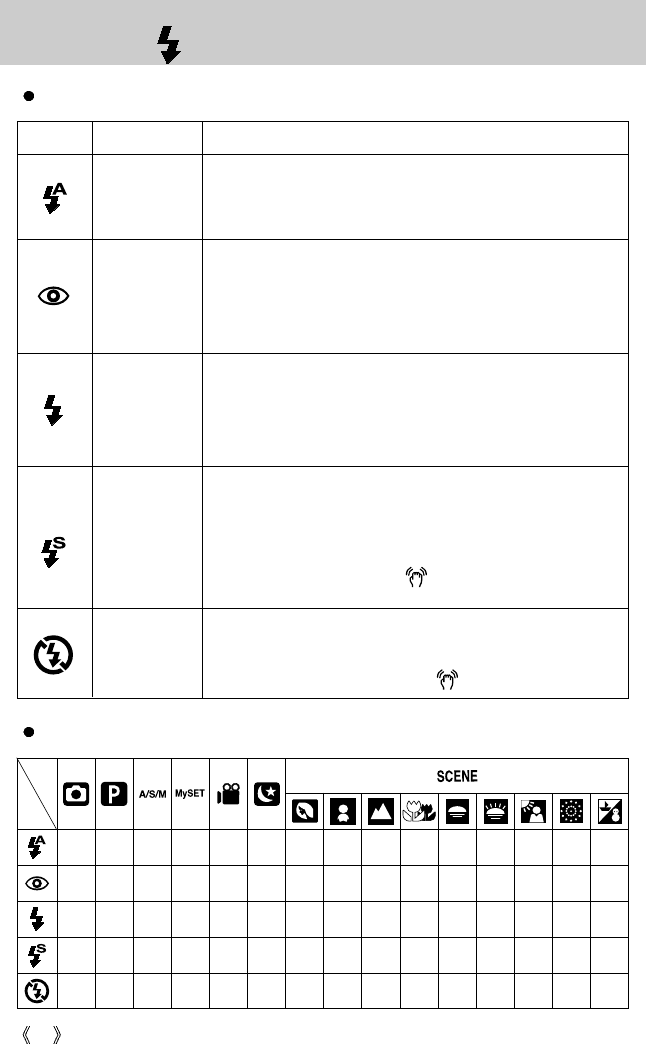
34
FLASH( ) / LEFT button
ICON Flash mode Description
Flash mode indicator
Available flash mode, by recording mode
If the subject or background is dark, the camera flash will operate
automatically.
Auto flash
Auto & Red eye
reduction
Fill in flash
Slow synchro
Flash off
If a subject or background is dark, the camera flash will work
automatically and will reduce the red-eye effect by using the red-eye
reduction function.
The flash will operate in conjunction with a slow shutter speed in order to
obtain the correct exposure. We recommend using a tripod for this
function. When you take an image in a condition with poor light, the
camera shake warning indicator ( ) will display on the LCD monitor.
The flash fires regardless of available light. The intensity of the flash will
be controlled, according to the prevailing conditions. The brighter the
background or subject is, the less intense the flash will be.
The flash does not fire. Select this mode when capturing images in a place or situation
where flash photography is prohibited. When you capture an image in a poorly lit
condition, the camera shake warning indicator ( ) will display on the LCD monitor.
XOXOXXXXXXXXXXO
OOXOXXOOXXX XXX X
XOOOXXXXXXXXOXX
XOOOXOXXXXXXXXX
OOOOOOX XOOOOXOX
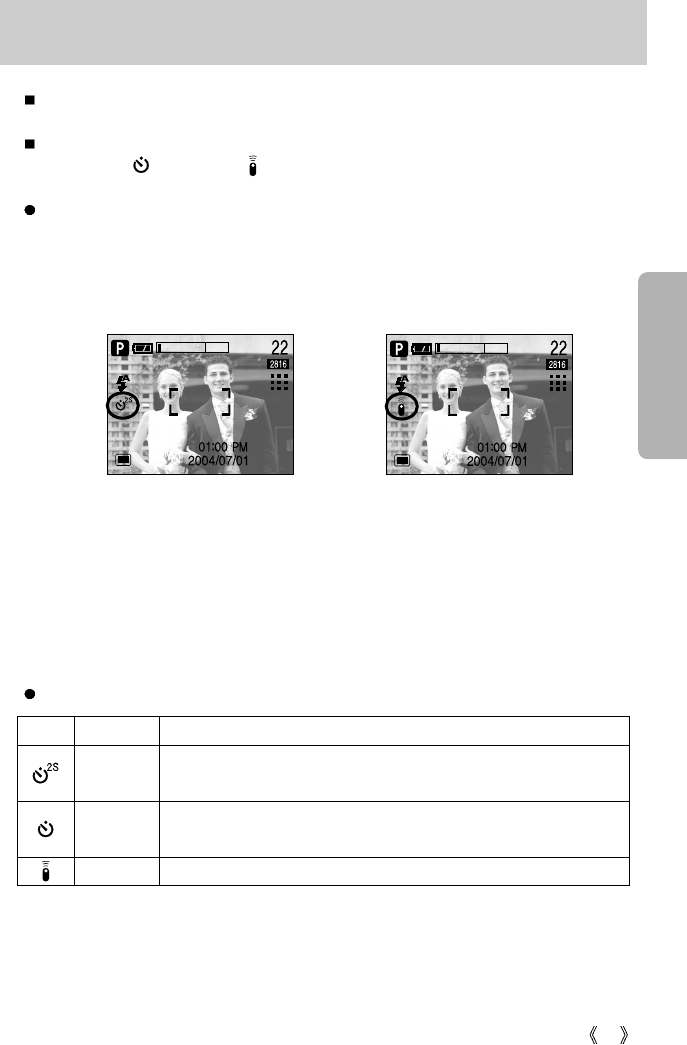
35
SELF-TIMER / REMOTE button
When the menu is displayed on the LCD monitor, pressing the RIGHT button makes the
cursor shift to the sub menu.
When the menu is not displayed on the LCD monitor, the RIGHT button operates as the
SELFTIMER ( ) / REMOTE ( ) button. This function is used when the photographer
would also like to be in the image.
Selecting the self-timer
1. Rotate the mode dial to the RECORDING mode.
Note that only remote controller shooting is available in the voice recording mode.
2. Press the SELF-TIMER button until the desired mode indicator displays on the LCD
monitor.
[ Selecting the 2sec. self-timer mode ]
[ Selecting the remote mode ]
Self-timer/ remote mode definition
Icon Mode Definition
Pressing the shutter button will allow an interval of 2 seconds
before the image is taken.
Pressing the shutter button will allow an interval of 10 seconds
before the image is taken.
Remote mode
You can take a picture with the remote controller.
- Selecting the self-timer mode :
Pressing the shutter button will allow an interval of ten seconds before the image is taken. After
that, the self-timer is cancelled.
- Selecting the remote mode :
Pressing the shutter button in the remote controller will allow an interval of 2 seconds before
the image is taken. In the remote mode, you cannot use the shutter button.
2s
10s
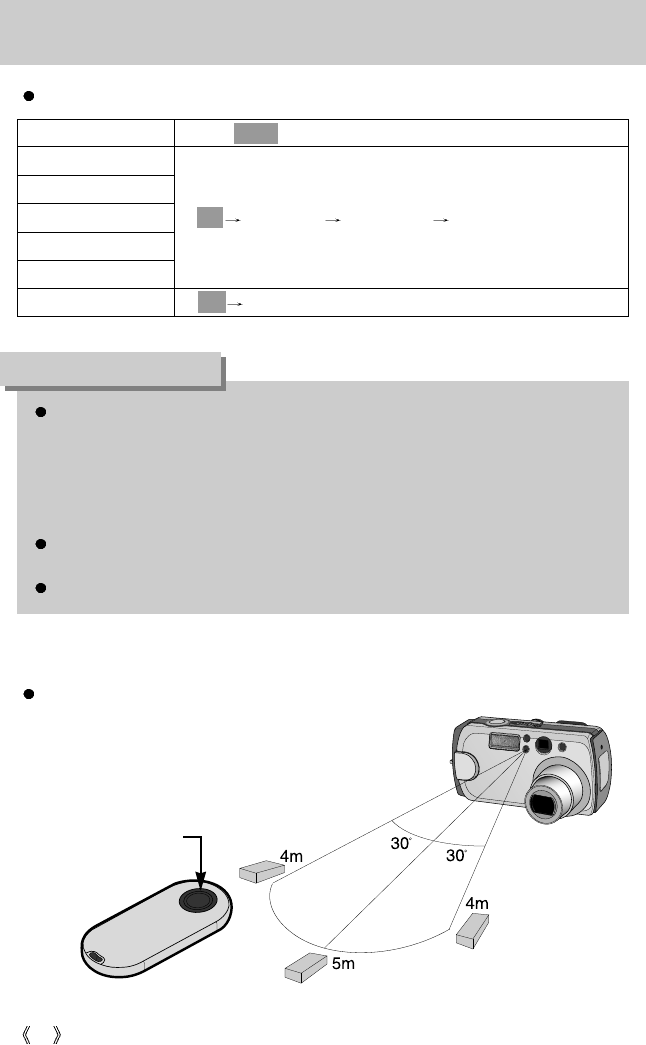
36
SELF-TIMER / REMOTE button
Self-timer/ remote mode setting
Remote control range
When you take a picture by using the remote control, refer
to the illustrations shown alongside about the remote
control range.
Off 2s self-timer 10s self-timer Remote
AUTO
PROGRAM
A/S/M, MySET
MOVIE CLIP
NIGHT SCENE, SCENE
VOICE RECORDING
Off Remote
[ Shutter button on the remote control ]
When taking a picture using the self-timer, the self-timer lamp works as follows:
2 second self-timer setting : The self-timer lamp blinks at 0.25 second interval for 2
seconds.
10 second self-timer setting : The self-timer lamp blinks at 1 second interval for the
first 7 seconds. It blinks at 0.25 second interval for the
remaining 3 seconds.
If you operate the Mode dial and Self-timer button during the self-timer operation, the self-
timer function is cancelled.
Use a tripod to prevent the camera from shaking.
INFORMATION
Mode dial Setting ( marked camera working mode is the default setting.)
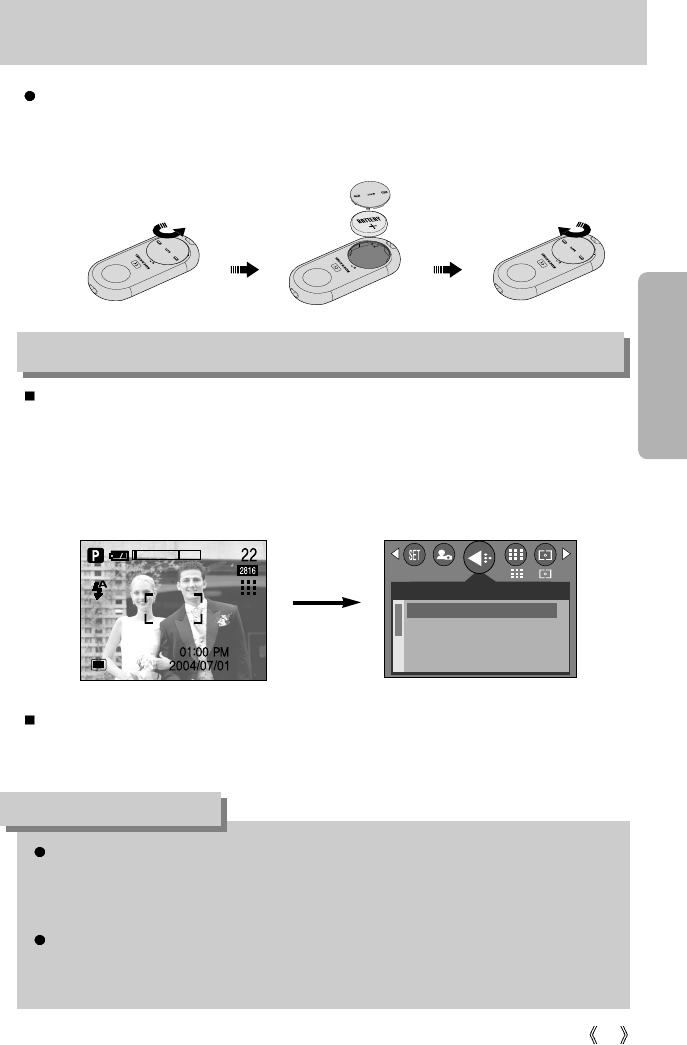
37
SELF-TIMER / REMOTE button
MEMU button
- When you press the MENU button, a menu related to each camera mode will be displayed
on the LCD monitor. Pressing it again will return the LCD to the initial display.
- A menu option can be displayed when the following are selected. AUTO, PROGRAM,
A/S/M, MySET, MOVIE CLIP, NIGHT SCENE and SCENE. There is no menu available
when the VOICE RECORDING mode is selected.
OK button
- When the menu is displayed on the LCD monitor, this button is used for shifting the cursor
to the sub menu or for confirming data.
Changing the remote controller battery
[ menu off ] [ menu on ]
Pressing the
MENU/OK button
MENU/ OK button
Check the polarity while installing the remote controller batteries. The + polarity must be
upward. Contact your dealer or Samsung camera service center for supplier details.
The battery type is CR 2025 3V.
The menu will not be displayed on the LCD monitor in the following circumstances:
- When another button is being operated.
-
While image data is being processed.( when the green LED next to the viewfinder blinks)
- When there is no battery capacity.
When the menu is showing on the LCD monitor, it is not possible to operate the shutter
button i.e. take an image. To take an image, simply cancel the menu display by pressing
the MENU button.
INFORMATION
SIZE
2816X2112
2560X1920
2272X1704
2048X1536
2816
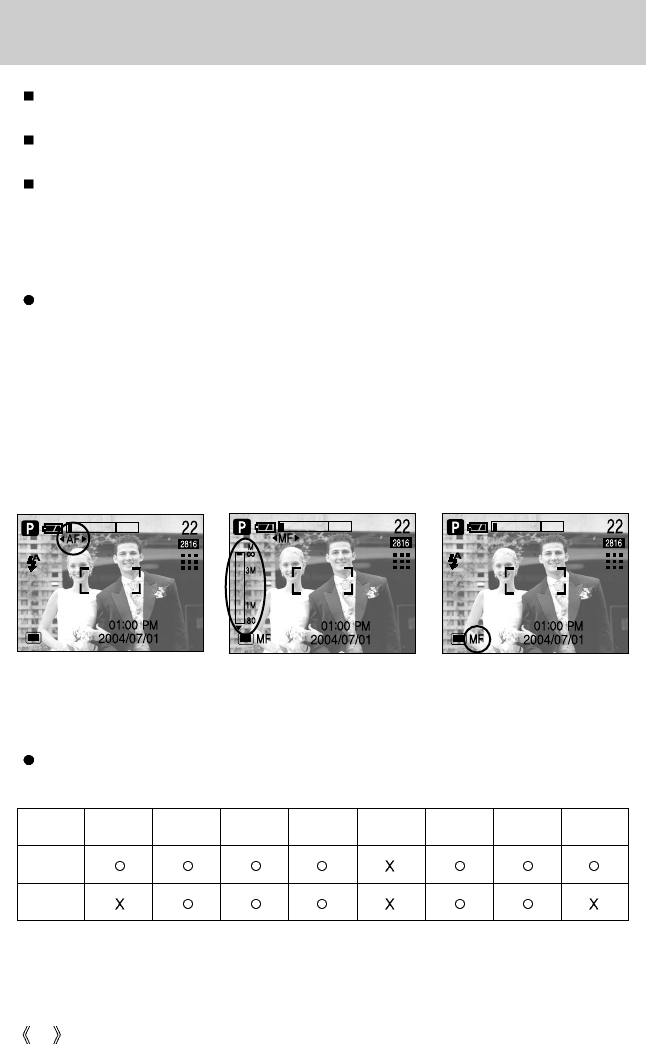
38
MF button
In dark conditions, the autofocus may not function. If this occurs, press the MF button and
you can select manual focus.
Carefully set the focus, using the MF button for focusing. If the focus is not accurate, the
picture may be blurred. Please set manual focusing carefully.
Use the MF button in A/S/M mode to change the Aperture value and Shutter speed.
Focusing
1. Press the MF button and use the Left/Right buttons to select automatic or manual
focusing.
2. The MF bar is displayed if manual focusing is selected.
Use the Up/Down buttons to set the desired distance.
- Pressing the UP button : Focus at long range.
- Pressing the DOWN button : Focus at close range.
3. After setting the manual focus, press the Menu/OK button to confirm.
The MF bar disappears and the MF icon is displayed in the bottom of the LCD.
[Select Auto Focusing] [After Setting the Manual Focus][Select Manual Focusing]
Available options for each shooting mode
(Available: O, Not available: X)
AUTO
PROGRAM
A/S/M MySET
VOICE RECORDING
MOVIE CLIP
NIGHT SCENE
SCENE
Auto focus
Manual focus
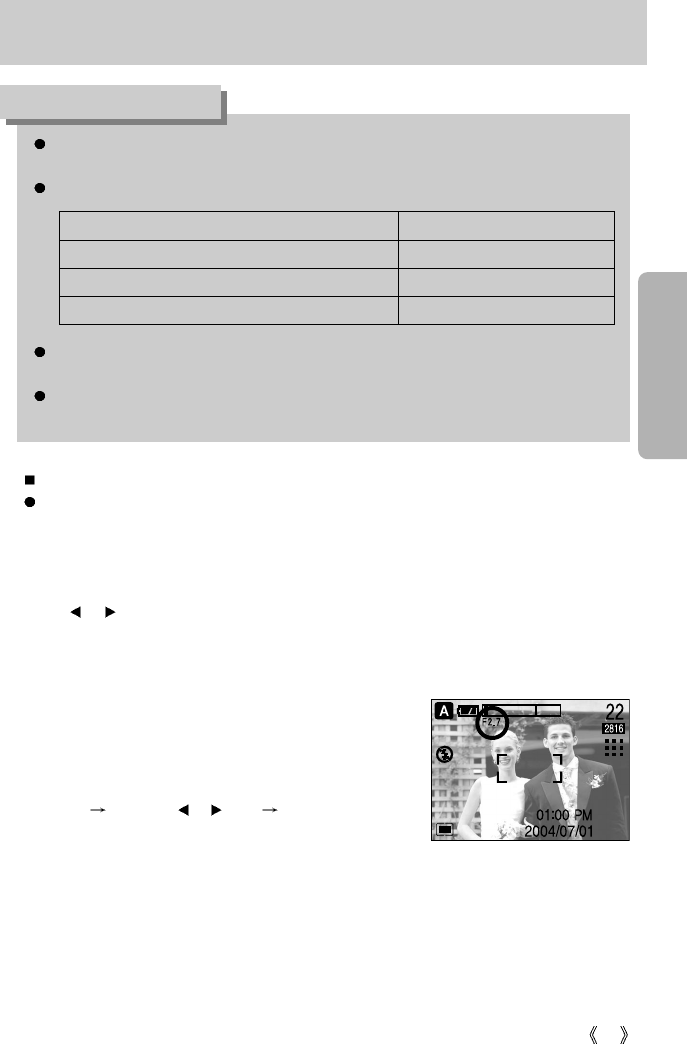
39
MF button
The manual focus function is disabled in the AUTO, VOICE RECORDING SCENE
modes.
The MF bar is divided into 3 parts according to the photography range.
When the subject distance is between 0.06m ~ 0.3m, the flash mode is changed to
FLASH OFF automatically.
The focus value displayed in the LCD while manually focusing is measured from the end
of the lens.
INFORMATION
Part of the MF bar Photography range
1st part 0.8m ~ infinity
2nd part 0.3m ~ 0.8m
3rd part (only in wide zoom mode) 0.06m ~ 0.3m
The MF button is used as described below in A/S/M mode.
A mode(Aperture priority mode)
1. Press the MF button. Aperture value in the LCD goes red.
2. Use the Left/Right buttons to set the desired Aperture value.
3. Press the MF or Menu/OK button to save the selected values.
- Pressing the MF button: Saves the new aperture value and displays the focus adjust icon
(AF ). To set manual focusing, set the distance as shown in page 38.
To set automatic focusing, press the MF button again.
- Pressing the Menu/OK button: The camera goes into shooting mode after saving the new
aperture value.
* Smaller Aperture values make the object sharp but blur
the background.
Larger Aperture values make both the object and
background sharp.
* Toggle the MF button in step 1 to select Aperture set
(Red) Focusing ( AF :Red) Aperture priority
mode (White)
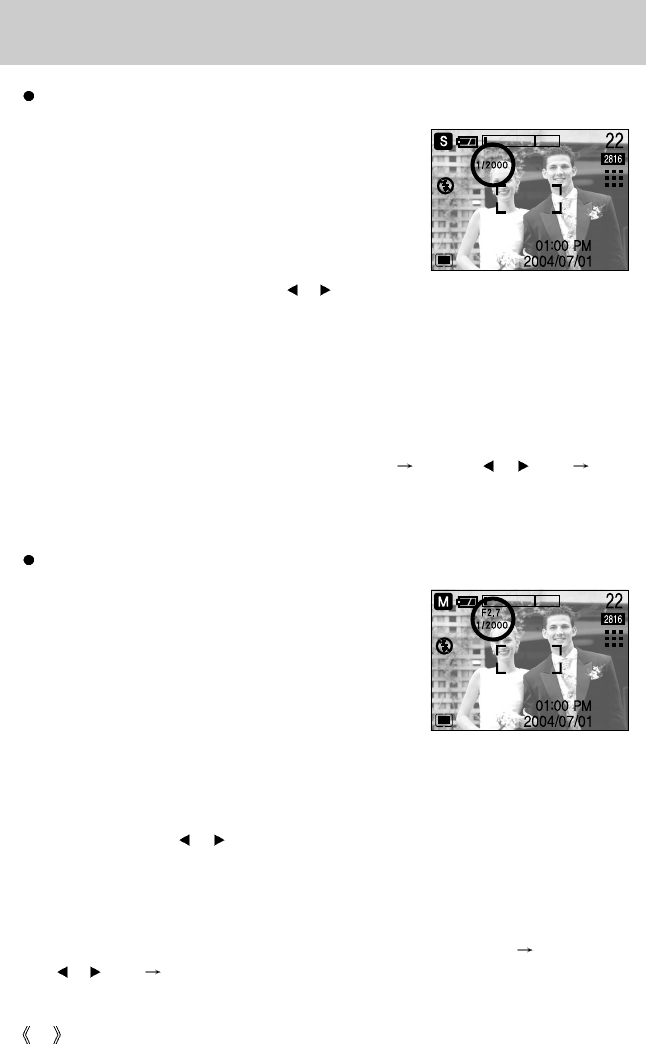
40
MF button
1. Press the MF button and wait for the shutter speed
value in the LCD to go red.
2. Use the Left/Right buttons to set the desired shutter
speed value.
3. Press the MF or Menu/OK button to save the selected
values.
- Pressing the MF button: Saves the new shutter speed
and displays the focus adjust icon ( AF ).
To set manual focusing, set the distance as shown in page 38. To set automatic focusing,
press the MF button again.
- Pressing the Menu/OK button: The camera goes into shooting mode after saving the new
shutter speed.
* High Shutter speeds can capture a moving object in a still image as if the object is not
moving.
Low Shutter speeds can capture a moving object with an ‘active’ effect.
* Toggle the MF button in step 1 to select Shutter speed Focusing ( AF : Red)
Shutter priority mode (White)
1. Both Aperture value and Shutter speed are displayed in
the LCD.
2. Press the MF button and wait for the Aperture value to
go red.
3. Use the Up/Down/Left/Right buttons to select the sub
menu option.
- Up/Down buttons: select the Aperture value or Shutter
speed.
- Left/Right buttons: Change the values
4. Press the MF or Menu/OK button to save the selected values.
- Pressing the MF button: Saves the new aperture value / shutter speed and displays the
focus adjust icon ( AF ). To set manual focusing, set the distance as shown in page
38. To set automatic focusing, press the MF button again.
- Pressing the Menu/OK button: The camera goes into shooting mode after saving the new
aperture value / shutter speed.
* Both the Shutter speed and Aperture value can be set.
* Toggle the MF button in step 1 to select Shutter speed/Aperture set (Red) Focusing
(AF : Red) Manual shooting mode (White)
S mode(Shutter priority mode)
M mode (Manual mode): manually set the Aperture value, Shutter speed, and Focusing.
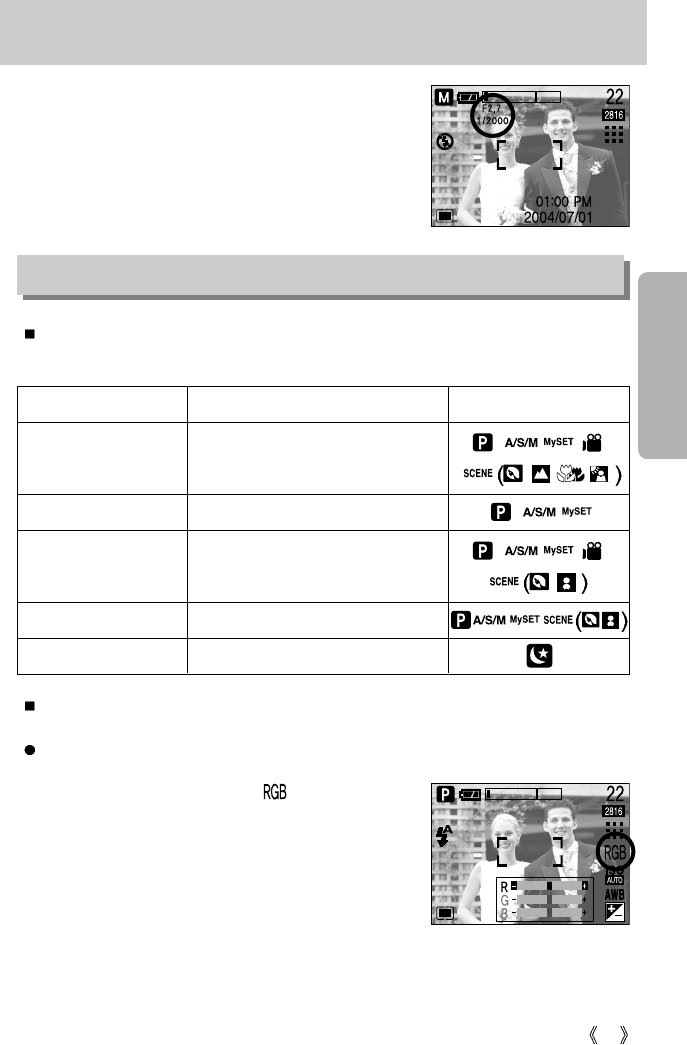
41
MF button
If the aperture value or shutter speed is out of the limit of
application, the value that is displayed on the LCD monitor will
show as red. However, you will still be able to take a picture.
Please adjust the shutter speed and aperture value so that
the red warning turns white (normal) before taking the picture.
+/- button
RGB : Allows the user to adjust the R (Red), G (Green), and B (Blue) values of the images to
be captured.
Setting RGB Values
1. Press the +/- button, and then use the UP and DOWN
buttons to select the RGB icon ( ).
The RGB menu bar will appear as shown.
2. Use the UP/ DOWN/ LEFT and RIGHT buttons to select
the desired RGB value.
- Up/Down Button: Navigates between R, G, and B
icons.
- Left/Right Button: Changes value of each icon.
3. When you press the +/- button again, the value you set
will be saved and RGB setup mode will end.
You can use the +/- button to adjust the values for the RGB, ISO, white balance, exposure
compensation and Long Time shutter speed.
Main menu Sub menu Available camera mode
RGB
Shutter speed/ Aperture value
Changed by zoom scale
-2.0~0.0~+2.0(0.5EV steps)
Exposure compensation
ISO
WHITE BALANCE
R (Red), G (Green), B (Blue)
AUTO, DAYLIGHT, CLOUDY, FLUORESCENT
H, FLUORESCENT L, TUNGSTEN, CUSTOM.
AUTO, 50, 100, 200, 400
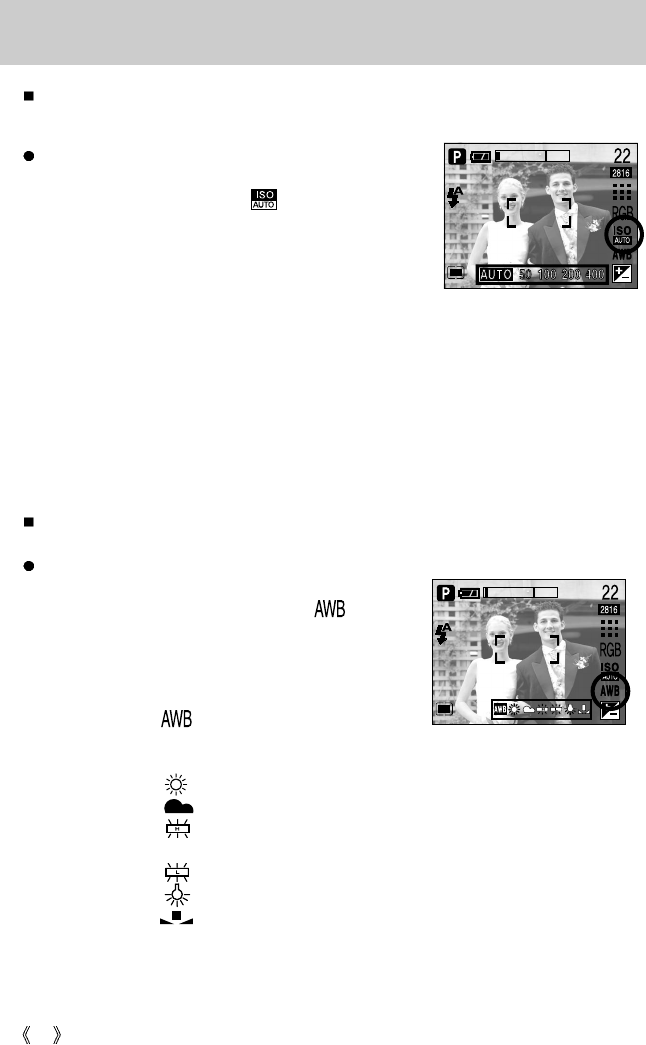
42
+/- button
Selecting an ISO Sensitivity
1. Press the +/- button, and the use the UP and DOWN
buttons to select the ISO icon( ). The ISO menu bar
will appear as shown.
2. Use the LEFT and RIGHT buttons to select the desired
ISO sensitivity value.
- AUTO :
The camera's sensitivity is automatically changed by
variables such as lighting value or subject brightness.
- 50, 100, 200, 400 :
You can increase the shutter speed while the same amount of light is present, by
increasing the ISO sensitivity. However, the image may be saturated in high luminance.
The higher the ISO value, the higher the camera’s sensitivity to light is and therefore the
greater its capacity to take pictures in dark conditions. However, the noise level in the
image will increase as the ISO value increases, making the image appear coarse.
3.
When you press the +/- button again, the value you set will be saved and ISO setup mode will end.
White balance : The white balance control allows you to adjust the colours to appear more
natural looking.
Selecting a White Balance
1. Press the +/- button, and then use the UP and DOWN
buttons to select the white balance icon ( ).
The white balance menu bar will appear as shown.
2. Use the LEFT and RIGHT buttons to set the white
balance to the desired value. The value you set will be
displayed on the LCD monitor.
AUTO : The camera automatically
selects the appropriate white
balance settings, depending on the prevailing lighting conditions.
DAYLIGHT : For taking images outside.
CLOUDY : For taking images under a cloudy and overcast sky.
Fluorescent H : For shooting under daylight fluorescent types of three-way
fluorescent lighting.
Fluorescent L : Shooting under white fluorescent lighting.
TUNGSTEN : For shooting under tungsten (standard light bulb) lighting.
CUSTOM : Allows the user to set the white balance according to the shooting
condition.
Different lighting conditions may cause a colour cast on your images.
3. Press the +/- button again. The value you set will be saved and White Balance setup mode
will end.
ISO: You can select the ISO sensitivity when taking pictures.
The speed or specific light-sensitivity of a camera is rated by ISO numbers.
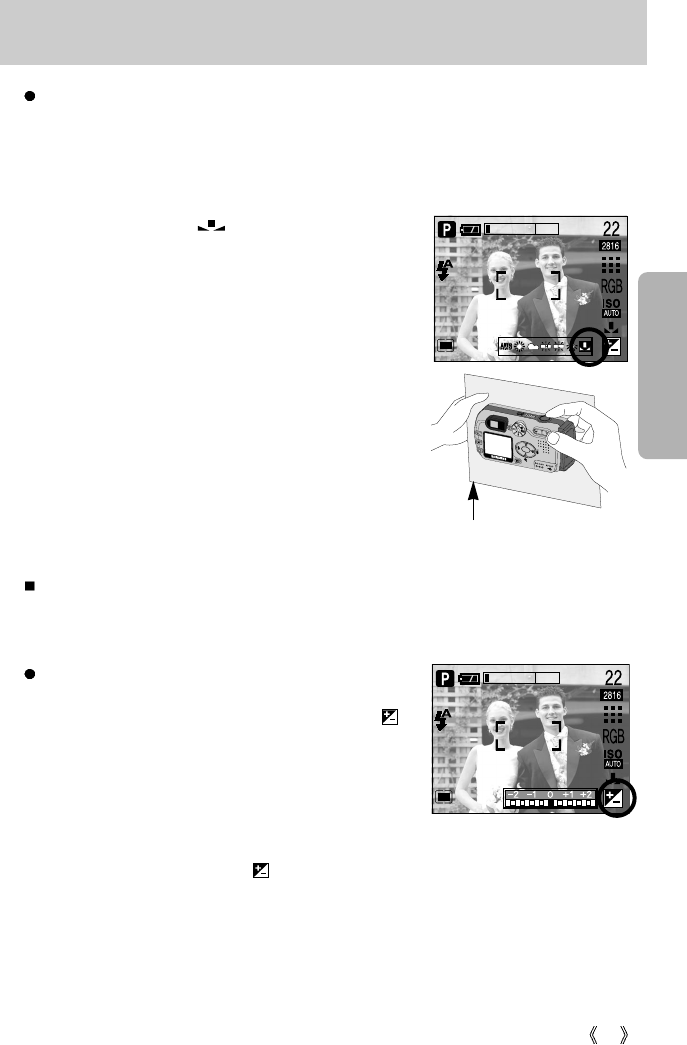
43
+/- button
Using the Custom White Balance
White balance settings may vary slightly depending on the shooting environment.
You can select the most appropriate white balance setting for a given shooting environment
by setting up the custom white balance.
1. Select the CUSTOM ( ) menu of the White
Balance.
2. Place a sheet of white paper in front of the camera so
that the LCD monitor shows only white, and then press
the SHUTTER button.
3. Your custom white balance value is stored.
- The custom white balance value will be applied,
starting with the next picture you take.
- The user configured white balance will be remain
effective until it is overwritten.
[ White paper ]
MEASURE:SHUTTER
Exposure compensation : This camera automatically adjusts the exposure according to the
ambient lighting conditions.
You can also select the exposure value by using the +/- button.
Compensating Exposure
1. Press the +/- button, and then use the UP and DOWN
buttons to select the exposure compensation icon ( ).
The exposure compensation menu bar will appear as
shown.
2. Use the LEFT and RIGHT buttons to set the desired
exposure compensation factor.
3. Press the +/- button again. The value you set will be
saved and the Exposure Compensation setup mode will close. If you change the exposure
value, the exposure indicator ( ) will be displayed on the bottom of the LCD monitor.
* A negative exposure compensation value reduces the exposure.
Note that a positive exposure compensation value increases the exposure and the LCD
monitor will appear white or you may not get good pictures.
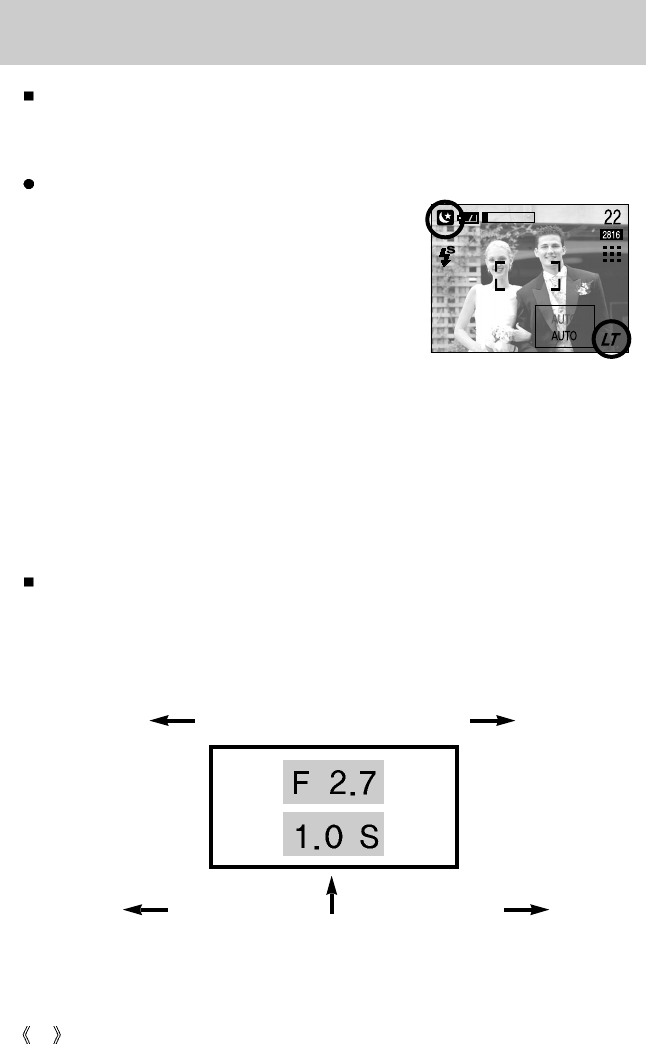
44
+/- button
Long Time shutter : This camera automatically adjusts the shutter speed and aperture values
to the shooting environment. However, in NIGHT SCENE mode, you can
set the shutter speed and aperture values to your preference.
Adjusting the shutter speed and aperture values
1. Select the NIGHT SCENE mode by rotating the mode
dial.
2. Press +/- button and Long Time shutter menu
(LT, For selecting shutter speed and aperture value) will
be displayed.
3. Configure the Long Time shutter value with the up/
down/ left/ right button.
Up/ Down Button: Select the iris / shutter speed
Left/ Right Button: Change the value. Available iris value options, depending on zoom step
will be displayed on the menu.
4. Press the +/- button again. The value you set will be saved and the mode will switch to
NIGHT SCENE mode. Press the SHUTTER button to take the picture.
(Press left button)
Aperture Value SmallLarge
(Press right button)
Shutter Speed
Fast
(Press left button)
Slow
(Press right button)
Aperture values and shutter speeds changed by zoom scale are listed below.
Supported Aperture Values: AUTO, F2.7 ~ F11
Supported Shutter Speeds: AUTO, 1/2000 ~ 16S
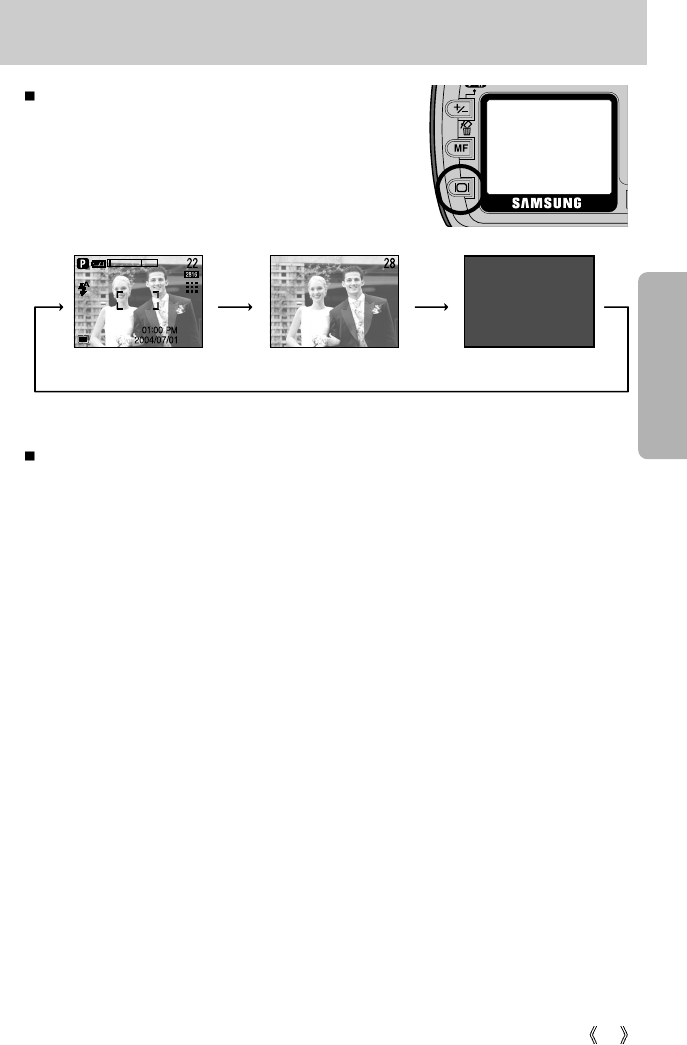
45
LCD button
[ Image & full information ]
[ Image & basic information ]
[ LCD off ]
You can check the recording status in the LCD monitor.
Toggle the LCD button in shooting mode (except in voice
recording mode) to display the next LCD information
displayed.
If the LCD monitor is turned off, the mode dial lamp will light up.
Pressing the
LCD button
Pressing the
LCD button
Pressing the LCD button
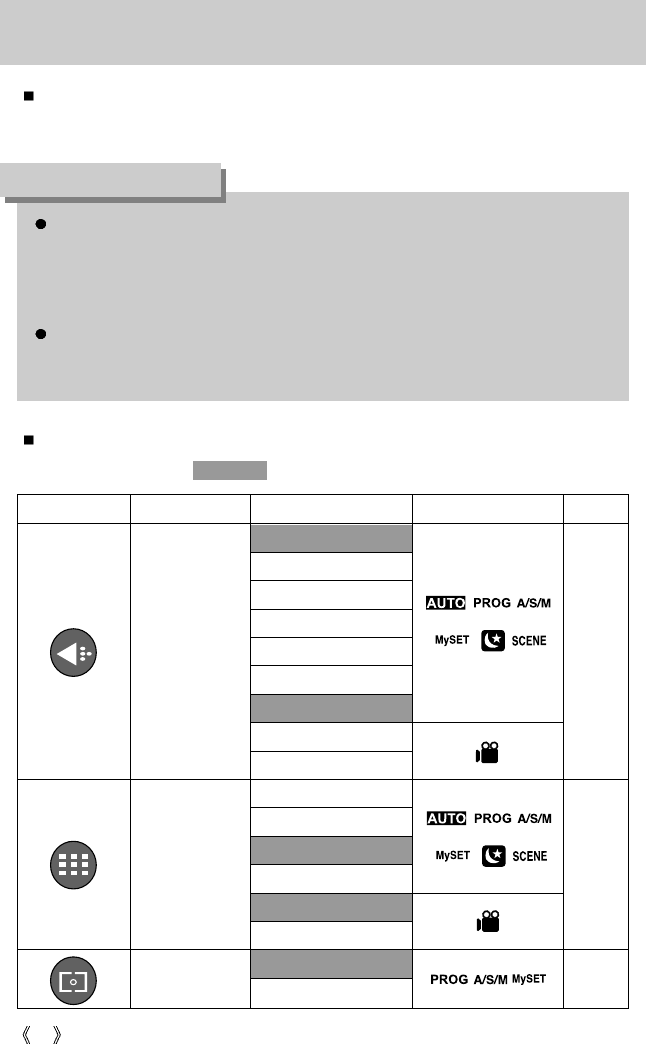
46
Using the LCD monitor to adjust the camera settings
You can use the menu on the LCD monitor to set up recording functions. In any mode with the
exception of VOICE RECORDING mode, pressing the MENU button displays the menu on the
LCD monitor.
The following functions are available, depending on the mode you have selected.
Menu tab Main menu Sub menu Camera working mode Page
2816X2112
2560X1920
2272X1704
2048X1536
1600X1200
1024X768
640X480
640X480
320X240
TIFF
S. FINE
FINE
NORMAL
30FPS
15FPS
MULTI
SPOT
The menu will not be displayed on the LCD monitor in the following circumstances:
- When another button is being operated.
- While image data is being processed.
(when the green LED next to the viewfinder blinks)
- When there is no battery capacity.
When the menu is showing on the LCD monitor, it is not possible to operate the shutter
button i.e. capture an image. To capture an image, simply cancel the menu display by
pressing the MENU button.
INFORMATION
The items indicated by are default settings.
METERING
SIZE
QUALITY
p.48
p.49
p.50
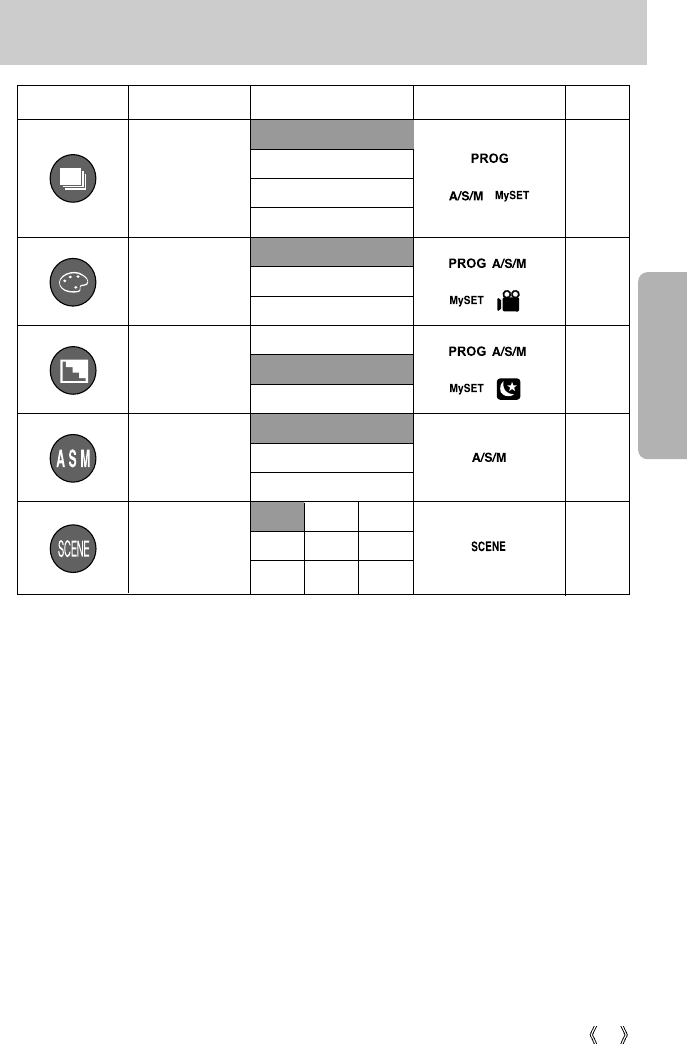
47
Using the LCD monitor to adjust the camera settings
EFFECT
SHOOTING
SHARPNESS
SCENE
ASM
p.50
p.51
p.52
p.52
p.53
* Menus are subject to change without prior notice.
Menu tab Main menu Sub menu Camera working mode Page
SINGLE
2 SHOTS
4 SHOTS
8 SHOTS
NORMAL
B & W
SEPIA
SOFT
NORMAL
VIVID
A
S
M
PORTRAIT CHILDREN
LANDSCAPE
CLOSE-UP
SUNSET
DAWN
BACKLIGHT FIREWORKS
BEACH&SNOW
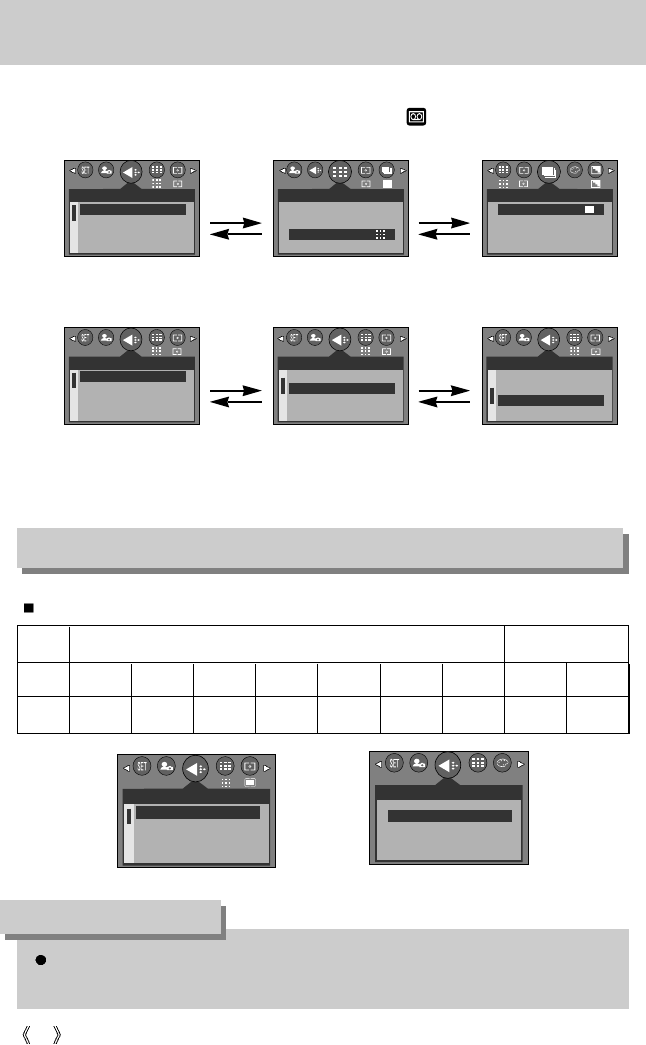
48
How to use the menu
3. Use the UP and DOWN buttons to select a sub menu.
4. Select a sub menu, and then press the OK button.
The value you set will be saved and the menu will disappear.
1. Turn on the camera and press the MENU button. A menu for each camera mode appears.
However, there is no menu for Voice Recording mode ( ).
2. Use the LEFT and RIGHT buttons to navigate through the menus.
AUTO
Press the UP or
DOWN button.
SIZE
2816X2112 2816
2560X1920
2272X1704
2048X1536
SIZE
2816X2112
2560X1920 2560
2272X1704
2048X1536
Press the UP or
DOWN button.
SIZE
2816X2112
2560X1920
2272X1704 2272
2048X1536
Size
You can select the image size appropriate for your application.
The higher the resolution, the lower the number of available shots will be because high
resolution images require more memory than lower resolution images.
INFORMATION
[ PROGRAM mode ] [ MOVIE CLIP mode ]
SIZE
2816X2112 2816
2560X1920
2272X1704
2048X1536
SIZE
640X480 640
320X240
NOR30FPS
Press the LEFT
or RIGHT button.
QUALITY
TIFF
S.FINE
FINE
NORMAL
SIZE
2816X2112 2816
2560X1920
2272X1704
2048X1536
SHOOTING
SINGLE
2 SHOTS
4 SHOTS
8 SHOTS
Press the LEFT
or RIGHT button.
2816 NOR
Mode
Icon 2816 2560 2272 2048 1600 1024 640 640 320
Size
2816X2112 2560X1920 2272X1704 2048X1536 1600X1200 1024X768 640X480 640X480 320X240
STILL IMAGE mode
MOVIE CLIP mode
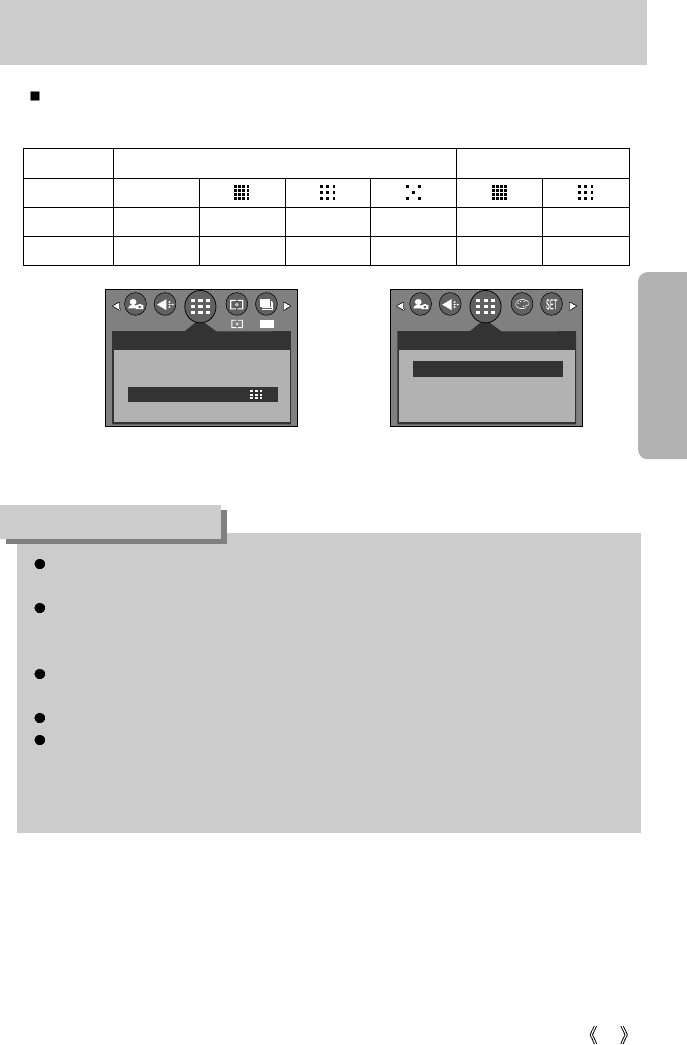
49
Quality
You can select the compression ratio appropriate for your application of the captured images.
The higher the compression ratio, the lower the picture quality.
Mode
Icon
Sub menu TIFF S.FINE FINE NORMAL 30FPS 15FPS
File Format tiff jpeg jpeg jpeg avi avi
STILL IMAGE mode MOVIE CLIP mode
TIFF
TIFF is the highest quality and NORMAL is the lowest setting.
Choose the setting appropriate for your needs.
TIFF format is an uncompressed image file format for an expert. If you take a picture with
the TIFF file format, the number of available shots is decreased and the time for recording
the image file will be longer because the TIFF file size is bigger than the JPG file format.
When the TIFF file is being recorded to the memory card, a [PLEASE WAIT!] message will
be displayed on the LCD monitor.
This file format complies with the DCF(Design rule for Camera File system).
JPEG (Joint Photographic Experts Group): JPEG is the image compression standard
developed by the Joint Photographic Experts Group. This type of compression is most
commonly used for compressing photos and graphics because it can compress the files
efficiently without damaging the data.
INFORMATION
[ PROGRAM mode ] [ MOVIE CLIP mode ]
2048
QUALITY
TIFF
S.FINE
FINE
NORMAL
2816 2048
FRAME RATE
30 FPS 30 FPS
15FPS
640 NOR
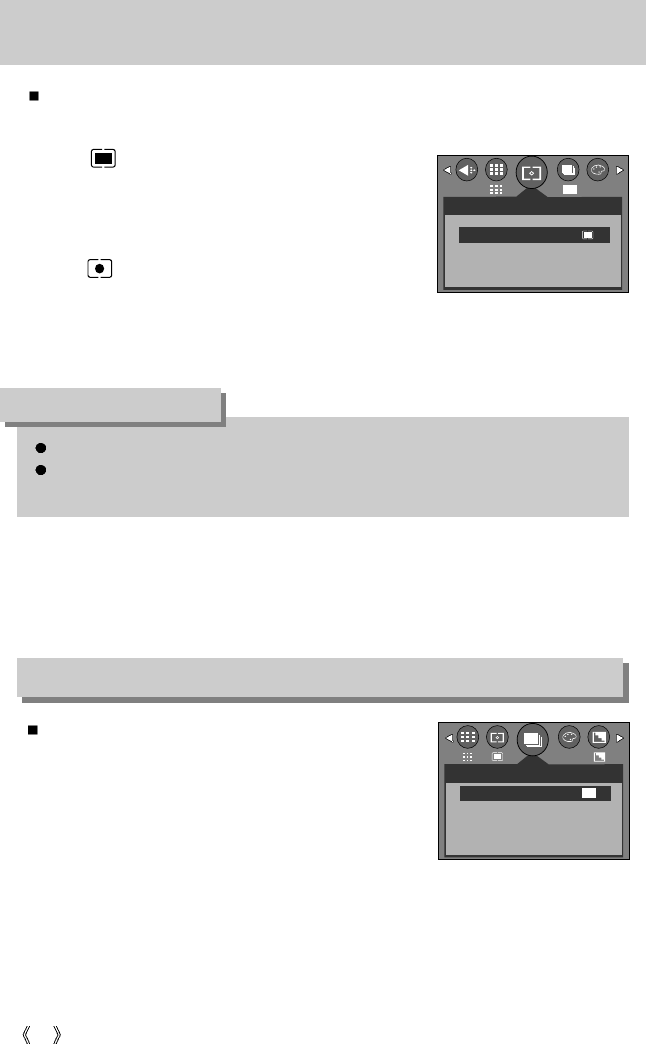
50
Metering
If you cannot obtain suitable exposure conditions, you can change the metering method to take brighter
pictures.
MULTI( ) :
Exposure will be calculated based on an
average of the available light in the image
area. However, the calculation will be
biased towards the centre of the image
area. This is suitable for general use.
SPOT( ) : Only the rectangular area in the center
of the LCD monitor will be metered for
light. This is suitable when the subject
in the center is exposed correctly, regardless of the back lighting.
The default metering mode is Multi pattern metering.
If the subject is not the centre of the focus area, do not use the spot metering as this may
result in an exposure error. In this circumstance, rather use exposure compensation.
INFORMATION
Continuous shot
Select the number of pictures in continuous shooting.
- [SINGLE] : Take one picture only
- [2, 4, 8 SHOTS] : Take the set number of pictures with one
push of the shutter. Continuous shooting
mode is cleared after one shooting.
2048
SHOOTING
SINGLE
2 SHOTS
4 SHOTS
8 SHOTS
NOR
[ PROGRAM mode ]
2048
METERING
MULTI
SPOT
2816 NOR
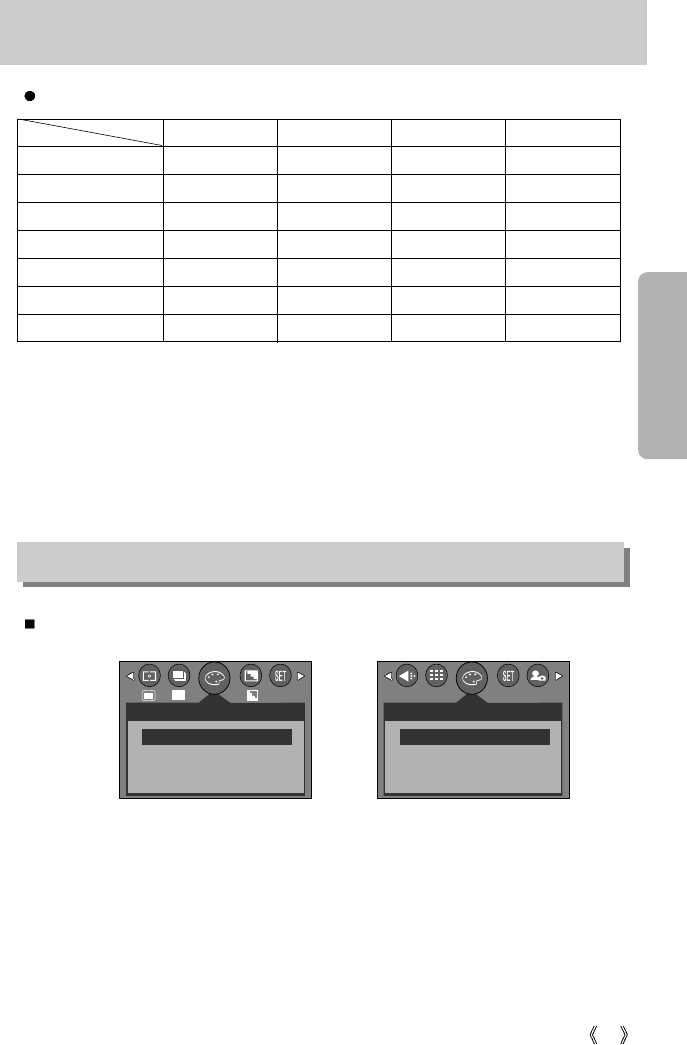
51
Continuous shot
By using the camera’s digital processor, it is possible to add special effects to your images.
[ PROGRAM mode ] [ MOVIE CLIP mode ]
NORMAL : No effect is added to the image.
B & W : Converts the image to black and white.
SEPIA : Captured images will be stored in a sepia tone (a gradient of yellowish brown
colours).
2048
EFFECT
NORMAL NOR
B & W
SEPIA
2048
EFFECT
NORMAL NOR
B & W
SEPIA
640
30FPS
Effect
Available maximum number of continuous shots, by image size/ quality type (Unit : shot)
* High resolution and picture quality increases file saving time, which increases stand-by time.
* Select [2, 4, 8 SHOTS] menu to inactivate the flash.
* Changing the image size after continuous shooting will clear the continuous shooting you set.
TIFF S.FINE FINE NORMAL
2816X2112 1 1 2 2
2560X1920 1 2 2 2
2272X1704 1 2 2 2
2048X1536 1 2 2 2
1600X1200 1 2 2 4
1024X768 1 4 8 8
640X480 1 8 8 8
quality
size
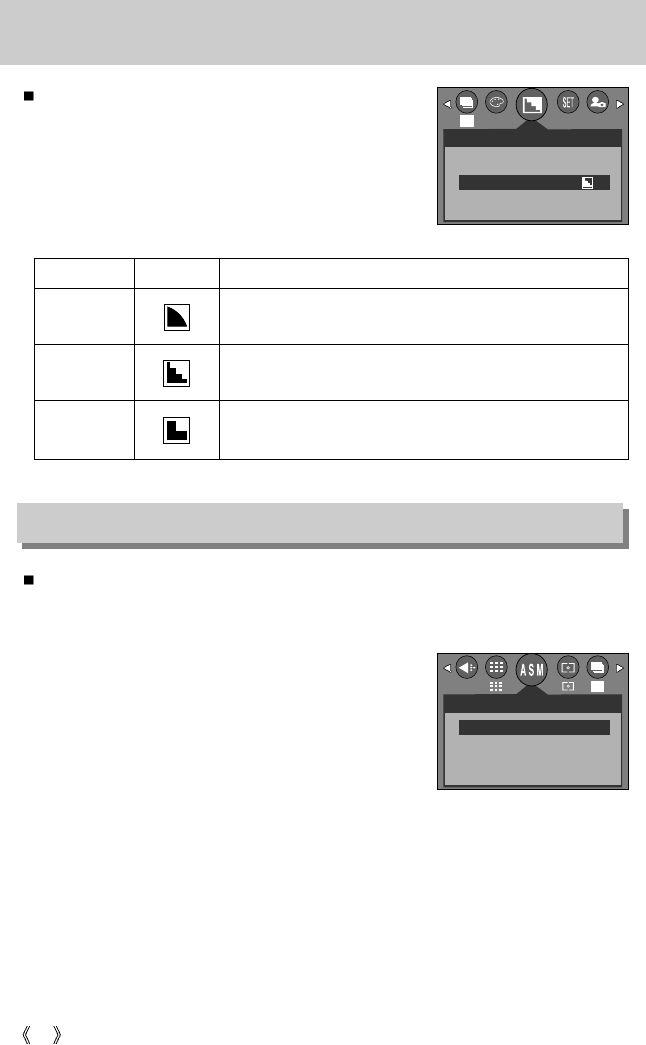
52
Sharpness
In this mode you can select the shutter speed or aperture value to your preference.
The menu is available in A, S, and M modes. Please see page 39 and 40 for details of each
mode.
1. Rotate the mode dial to the A/ S/ M mode and press the
MENU button.
2. Select [ASM] menu by pressing the LEFT/RIGHT button.
3. Select the desired sub menu by pressing the UP/DOWN
button.
- A mode (Aperture priority) :
You can select the aperture value in this mode.
The camera calculates the best shutter speed
automatically to the proper exposure value.
- S mode (Shutter priority) :
You can select the shutter speed in this mode. The camera calculates the best aperture
value automatically to the proper exposure value.
- M mode (Manual) :
You can select the shutter speed and the aperture value in this mode.
4. Press the OK button to save the desired shooting mode.
You can adjust the sharpness of the picture you want to
take. You cannot check the sharpness effect on the LCD
monitor before you take a picture, because this function is
applied only when the captured image is stored on the
memory.
[ PROGRAM mode ]
Sub menu Icon Description
The edges of the image are softened. This effect is suitable
for editing images on your PC.
The edges of the image are sharp.
This is suitable for printing.
The edges of the image are emphasized. The edges will
appear sharp, but noise may occur in the recorded image.
VIVID
NORMAL
SOFT
2048
SHARPNESS
SOFT
NORMAL
VIVID
NOR
A/S/M
2048
ASM
AA
S
M
2816
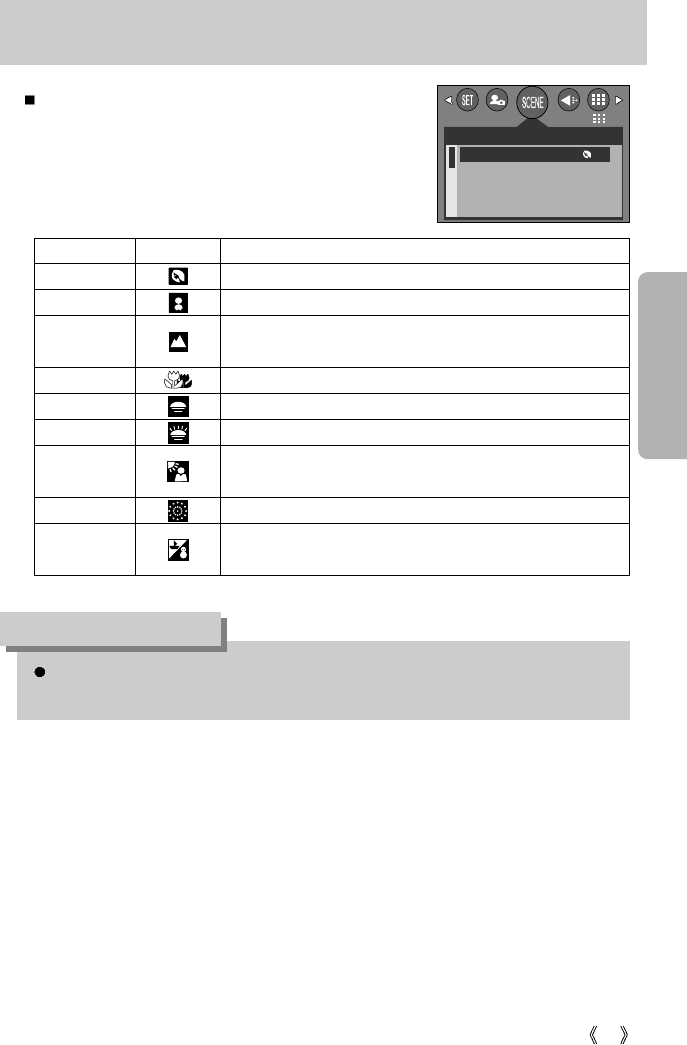
53
Scene
Sub menu Icon Description
CHILDREN
PORTRAIT
LANDSCAPE
CLOSE-UP
SUNSET
DAWN
BACKLIGHT
FIREWORKS
BEACH &
SNOW
Select the [SCENE] submenu to automatically configure
optimal settings, depending on the selected scene.
Only available in the Scene Mode.
Take a still picture of capturing moving children.
To take picture of a person.
Close-up shooting for small objects such as plants and insects.
Splendor of the setting sun.
Scenery with green woods or blue sky.
Portrait with scenery background.
Daybreak scenes.
Portrait without shadows caused by back light.
Firework scenes.
For ocean, lake, and beach scenes and snowscapes.
2048
SCENE
PORTRAIT
CHILDREN
LANDSCAPE
CLOSE-UP
2816
When close-up, sunset, dawn, fireworks scene mode are selected, it is possible that
camera shake will occur. If you think this will happen, use a tripod.
INFORMATION
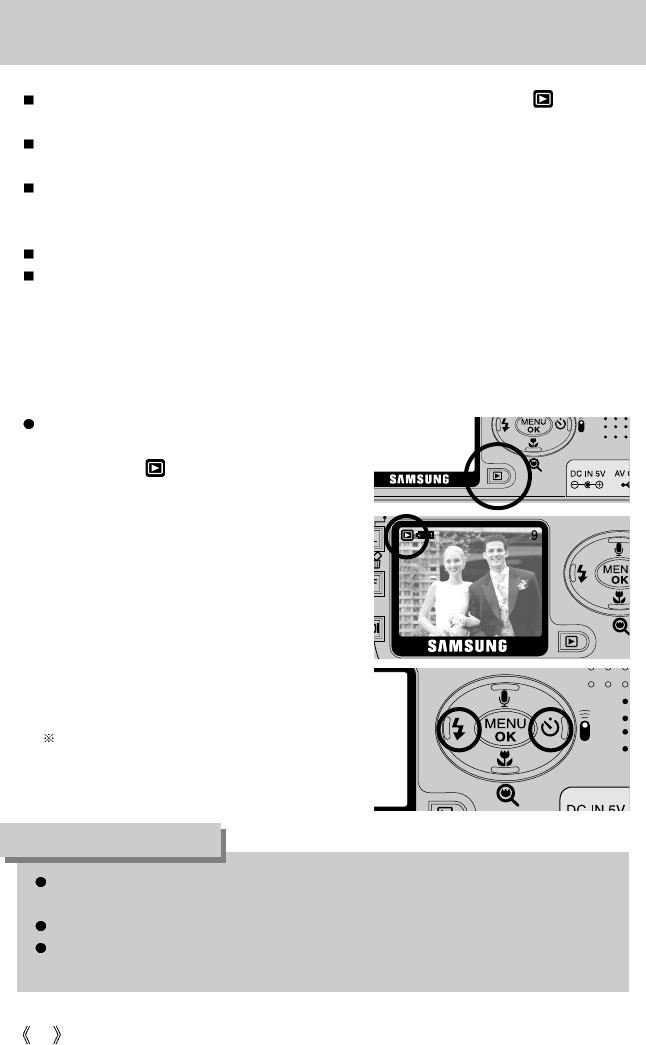
54
Starting play mode
Turn the camera on and select Play mode by pressing the play mode button ( ).
The camera can now play back the images stored in the memory.
Slide the power switch to turn the camera power on. Press the play mode button once to
switch to play mode. Press the play mode button again to switch to shooting mode.
You can turn the power on with the play mode button. The camera is turned on in play mode.
Press the play mode button again to turn the power off. Switch the mode dial to change to
another shooting mode while the camera is on.
You can set up the PLAY mode function by using the camera buttons and LCD monitor.
If you press PLAY button to switch to Play mode, the camera lens will retract into the camera
body for protection of the lens in about 10 seconds.
3. Select an image that you want to play back by
pressing the LEFT / RIGHT button.
Press and hold the Left or Right button to fast
forward the images played.
2. The last image stored on the memory is
displayed on the LCD monitor.
Playing back a still image
1. Select the PLAY mode by pressing the play
mode button ( ).
Manner mode : Press the play mode button for more than 3 seconds and the camera will be
turned on without the start-up sound and the [SOUND] function will be disable.
Even if the camera' s power is off, you can start the play mode by pressing the play mode button.
Lightly press the shutter button in Play mode to switch to the currently set shooting mode
with the mode dial.
INFORMATION
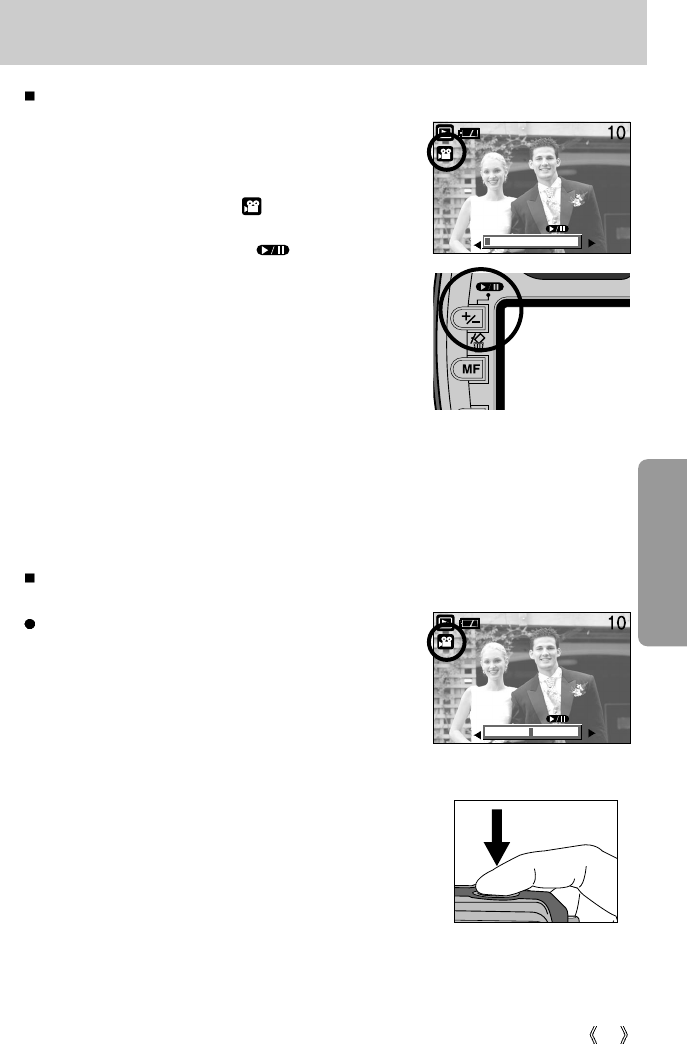
55
Starting play mode
Playing back a movie clip
Steps from 1-2 are the same as those to play back a still
image.
3. Select the recorded movie clip that you want to play back
by using the LEFT/RIGHT button. If you select a movie
clip, the movie clip indicator ( ) will be displayed on the
LCD monitor.
4. Press the play & pause button ( ) to play back a
movie clip file.
- To pause a movie clip file while playing it back, press the
play & pause button again.
- Pressing the play & pause button again will cause the
movie clip file will restart.
- To rewind the movie clip while it is playing, press the
LEFT button. To fast forward the movie clip, press the
RIGHT button.
- To stop playback of the movie clip, press the play & pause button, and then press the
LEFT or RIGHT button.
PLAY
REW FF
PLAY
REW FF
How to capture the movie clip
Steps 1-2 are the same as those for playing back a still
image.
3. Select the recorded movie clip that you want to play
back by using the LEFT/RIGHT button.
4. Press the Play/Pause button to play the movie clip
5. Press the Play/Pause button while playing the movie
clip. Then press the Shutter button.
6. The paused movie clip is saved in a new file name.
* The captured movie clip file has same size as the original
movie clip (640X480 or 320X240)
Movie clip capture function: capture still images from the movie clip.
[ Paused ]
[ Press the shutter button ]
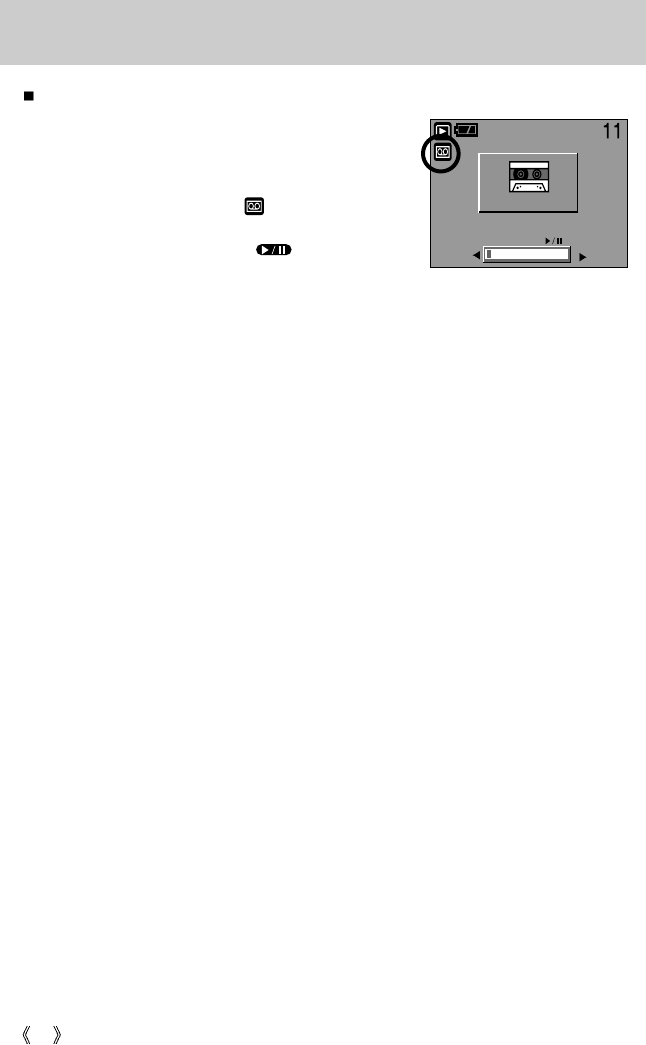
56
Starting play mode
Playing back a recorded voice
Steps from 1-2 are the same as those to play back a still
image.
3. Select the recorded voice that you want to play back by
using the LEFT/RIGHT button. If you select a recorded
voice file, the voice indicator ( ) will be displayed on
the LCD monitor.
4. Press the play & pause button ( ) to play back a
recorded voice file.
- To pause a recorded voice file, while playing it back, press
the play & pause button again.
- To resume playback of the voice file, press the play & pause button.
- To rewind the voice file while it is playing, press the LEFT button. To fast forward the voice
file, press the RIGHT button.
- To stop playback of the voice file, press the play & pause button, and then press the LEFT
or RIGHT button.
PLAY
REW FF
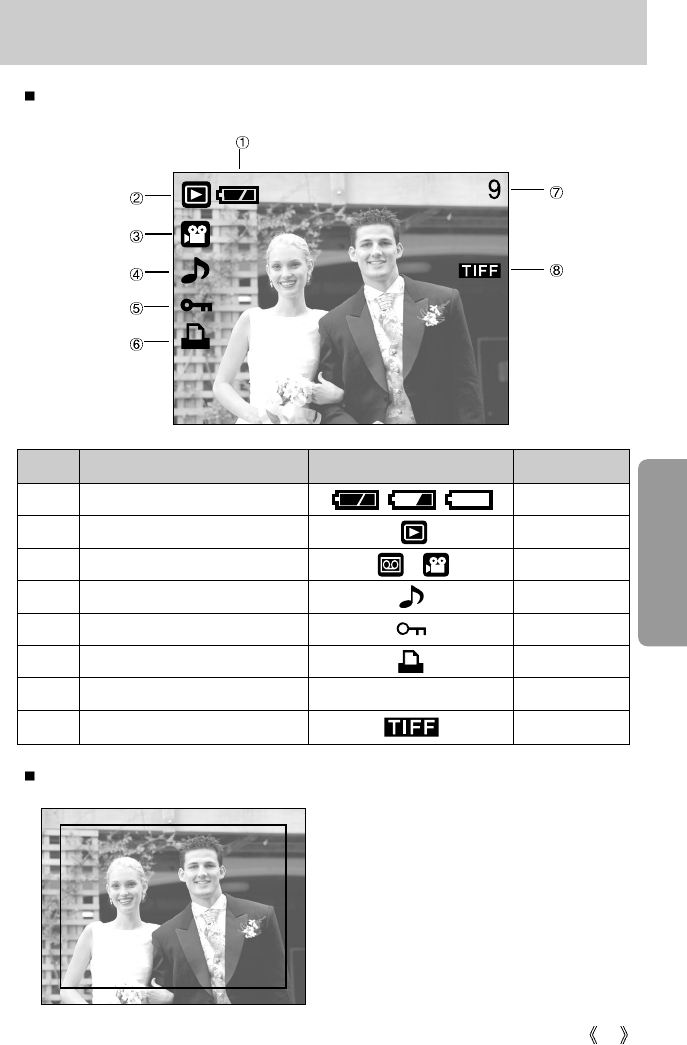
57
LCD monitor indicator
The LCD monitor displays information about the shooting conditions.
No. Description Icon Page
1 Battery p.16
2 Play mode
3 File Type
4 Voice memo p.60
5 Protect indicator p.67
6 DPOF indicator p.70
7 Stored image number 9
8 TIFF file
SIZE : 2816X2112 Size
AV : F2.7 Aperture value
TV : 1/30 Shutter speed
ISO : 50 ISO sensitivity
FLASH : OFF Whether or not the
flash is used.
DATE : 2004/07/01 Recording date
SIZE : 2816X2112
AV : F2.7
TV : 1/30
ISO : 50
FLASH : OFF
DATE : 2004/07/01
If you press the LCD button, you can check the following recording information:
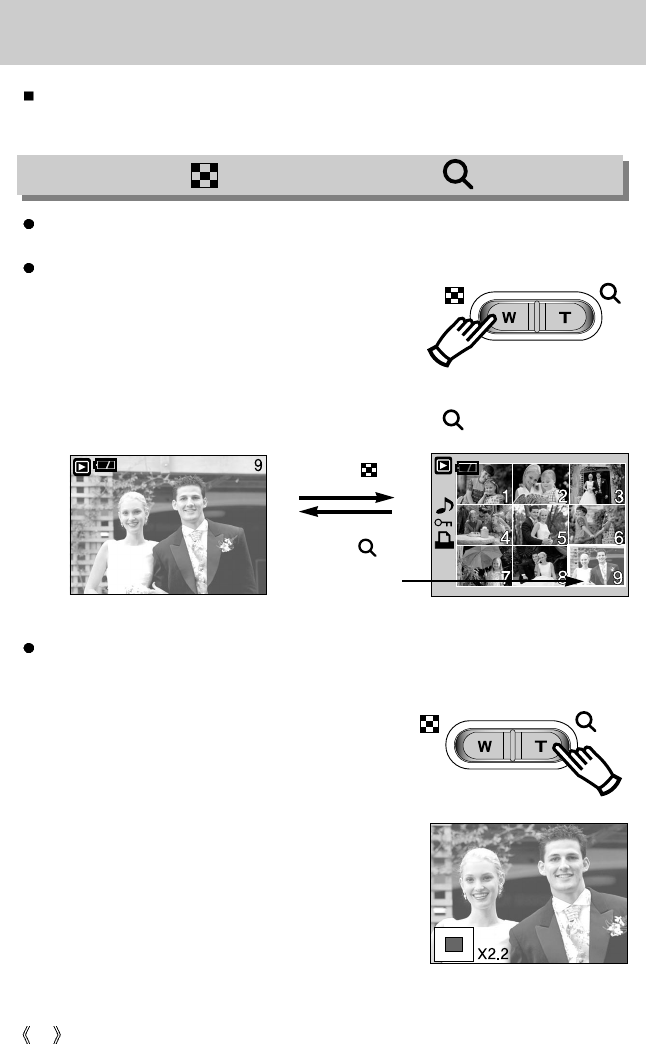
58
Thumbnail ( ) / Enlargement ( ) button
Using the camera buttons to adjust the camera
In Play mode, you can use the buttons on the camera to conveniently set up the Play mode
functions.
Image enlargement
1. Select an image that you want to enlarge and press the enlargement button.
2. Different parts of the image can be viewed by pressing
the 5 function button.
3. Pressing the thumbnail button will zoom back to the
original full sized image.
- You can tell whether the image displayed is an
enlarged view by checking the image enlargement
indicator shown at the bottom left of the LCD monitor.
(If the image is not an enlarged view, the indicator will
not be displayed.) You can also check the area of
enlargement.
-TIFF, Movie clips and WAV files can’t be enlarged.
- If an image is enlarged, a loss of quality may occur.
[ Normal display mode ] [ Thumbnail display mode ]
Pressing the thumbnail
button ( )
Pressing the enlargement
button ( )
Highlighted image
You can view multiple pictures, enlarge a selected picture, and crop and save a selected area
of an image.
Thumbnail display
1. While an image is displayed full screen, press the
thumbnail button.
2. The thumbnail display will highlight the image that had
been showing at the time the thumbnail mode was
selected.
3. Press the 5 function button to move to a desired image.
4. To view an image separately, press the enlargement button ( ).
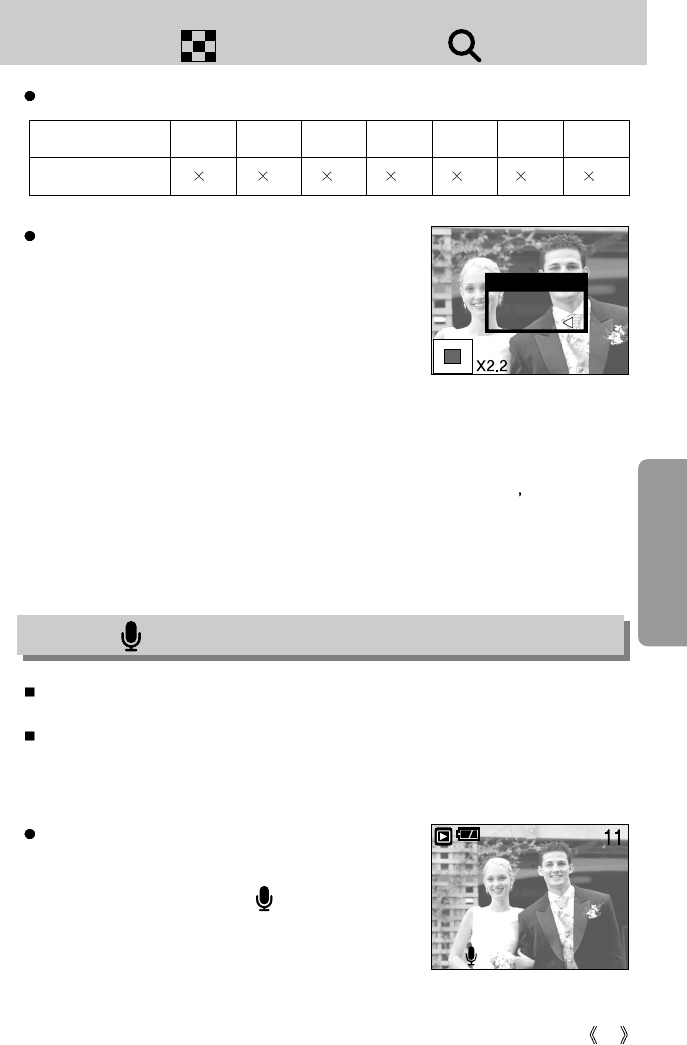
59
Thumbnail( ) / Enlargement( ) button
The maximum enlargement rate in proportion to the image size.
Trimming : You can extract part of the image that you want
and save it separately.
1. Select an image that you want to enlarge and press the
enlargement button.
2. Different parts of the image can be viewed by pressing
the 5 function button.
3. Press the MENU button and a message will be
displayed as shown alongside.
4. Press the OK button to save the trimmed image with a
new file name.
The trimmed image will be displayed on the LCD monitor.
Press the LEFT button to return to the image before it was selected.
- If there is little memory space to save the trimmed image, the image can t be trimmed.
* Trimming is not available for TIFF images
Voice ( ) memo / Up button
When the menu is displayed on the LCD monitor, pressing the UP button makes the menu
cursor move up.
When the menu is not displayed on the LCD monitor, the UP button operates as the voice
memo button. You can add your voice to a stored still image.
Adding a Voice Memo to a Still Image
1. Press the LEFT/ RIGHT button to select an image that
you wish to add sound to.
2. Press the voice memo button ( ) and the voice memo
indicator will display. The camera is now ready to record
a voice memo.
TRIMMING?
TRIM:OK
CANCEL:
START:SHUTTER
Image size
2816 2560 2272 2048 1600 1024 640
Maximum enlargement rate
11 10 8.8 8.0 6.2 4.0 2.5
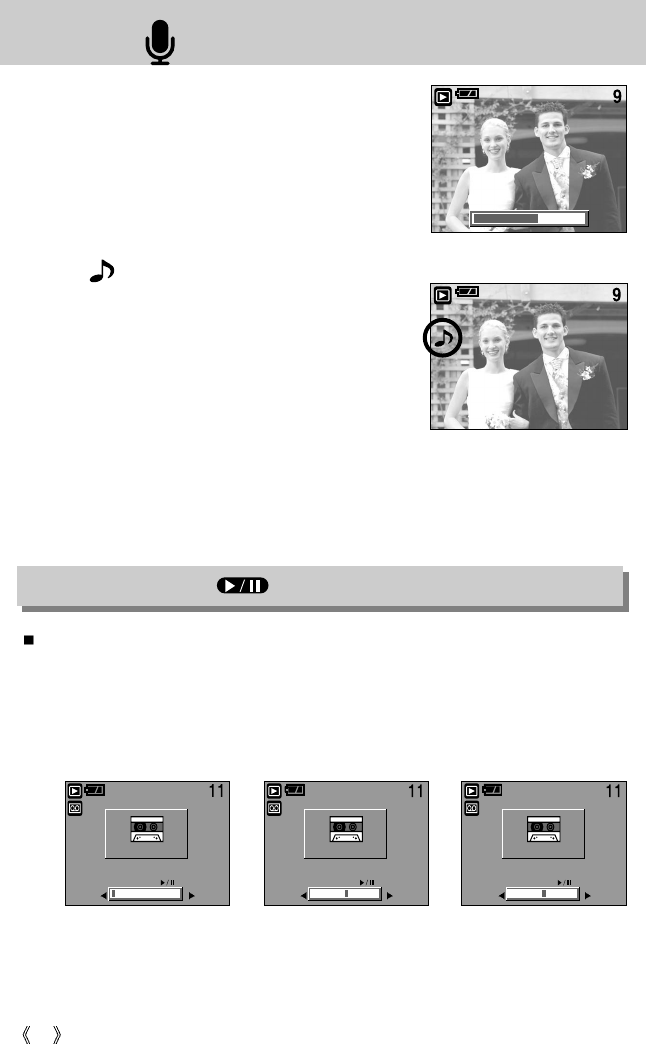
60
Voice ( ) memo / Up button
3. Press the shutter button to start recording and voice will
be recorded to the still image for 10 seconds. While the
voice is recording, the recording status window will be
displayed as shown alongside.
4. The recording can be stopped by pressing the shutter
button again.
5. The ( ) icon will be displayed on the LCD monitor
after voice memo recording has finished.
- Voice memos can’t be recorded onto movie clip files.
- A distance of 40cm between you and the camera
(microphone) is the best distance to record sound.
- The voice memo will be saved in *.wav format, but has
the same file name as the still image to which it
corresponds.
- If you add a new voice memo to the still image that
already has a voice memo, the existing voice memo will be erased.
Play & Pause ( ) button
In Play mode, the play & pause button works as follows:
- If a still image with a voice memo, a voice file, or a movie clip is playing
In Stop mode : Plays a still image with a voice memo, a voice file, or a movie clip.
During playback : Temporarily stops playback.
In Pause mode : Resumes playback
[ Voice recording is stopped ] [ Voice recording is paused ][ Voice recording is playing ]
STOP:SHUTTER
PLAY
REW FF PAUSE
REW FF PLAY
REW FF